Abstract
Tourette syndrome (TS) is a common, hereditary, neurobehavioral disorder of childhood. To determine the frequency of various behavioral manifestations, we have compared 47 random normal controls to 246 patients with TS, 17 with attention-deficit disorder (ADD), and 15 with ADD secondary to a TS gene (ADD 2(0) TS). All subjects were examined prospectively with a 425-item questionnaire based on the Diagnostic Interview Schedule and the Diagnostic and Statistical Manual of Mental Disorders (DSM III). The TS patients were divided into grade 1 (too mild to treat [17.5%]), grade 2 (requiring treatment [58.9%]), and grade 3 (severe [23.6%]). Patients in all three grades of TS were significantly different from controls for DSM III symptoms of inattention, impulsivity, and hyperactivity. Sixty-two percent of TS patients had ADD, compared with 6.3% of controls; and 48.8% had ADD with hyperactivity (ADDH), compared with 4.2% of controls. In the majority of TS patients, the natural history of the disease was to start with ADDH and 2.4 years later develop motor and vocal tics. Among TS patients, 39% had previously received medication for ADDH or behavior problems, compared with 2% of the controls. Although stimulants can occasionally exacerbate tics, there was no evidence that stimulants cause TS and they are often a valuable adjunct to the treatment of TS. It is estimated that 10%-30% of ADDH is due to or associated with the presence of a TS gene. TS patients had a significantly increased frequency of (1) attending classes for the educationally handicapped, (2) placement in classes for the severely emotionally disturbed, (3) attending any special classes, (4) severe test anxiety, (5) stuttering, (6) letter, number, or word reversal, (7) reading very slowly, and (8) poor retention of material read. A reading-problem score (dyslexia) greater than or equal to 3 was present in 26.8% of TS patients, compared with 4.2% of controls. Number reversal, word reversal, and poor retention were significant even for the TS patients with tics too mild to treat. The multiple ways in which TS impacts school performance, as well as potential remedies, are discussed.
Full text
PDF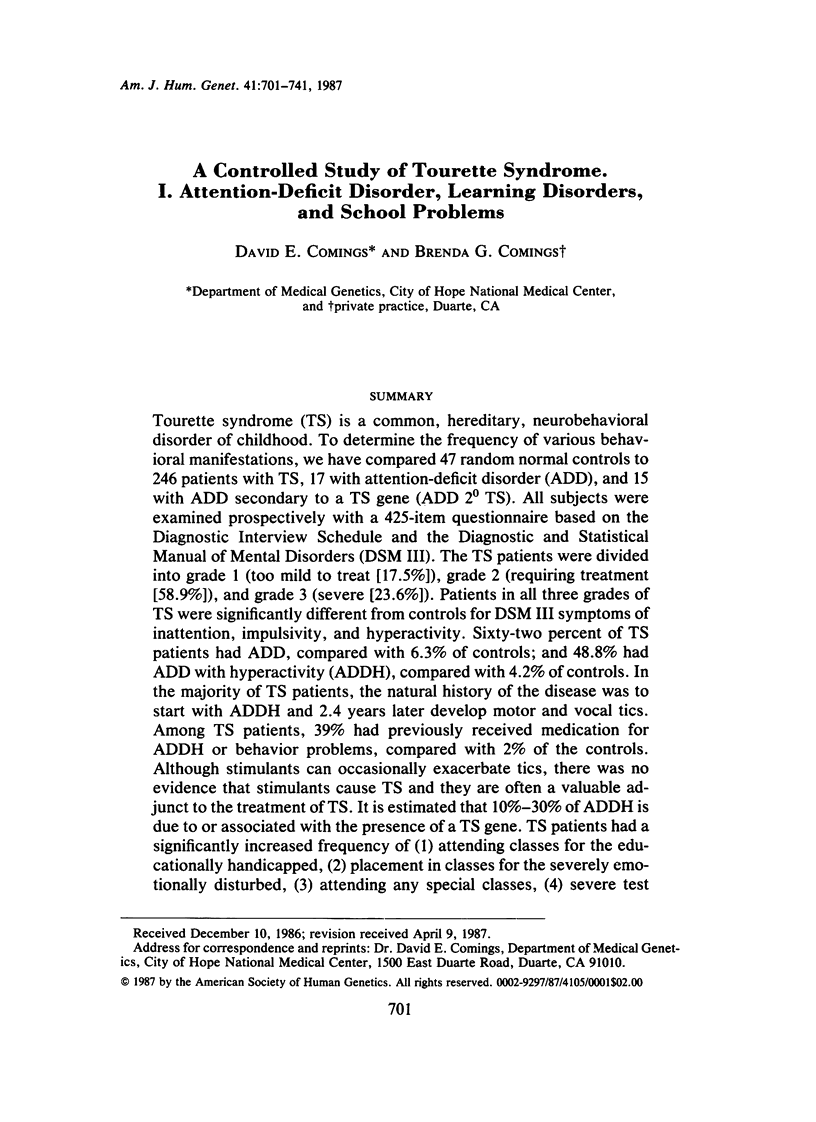
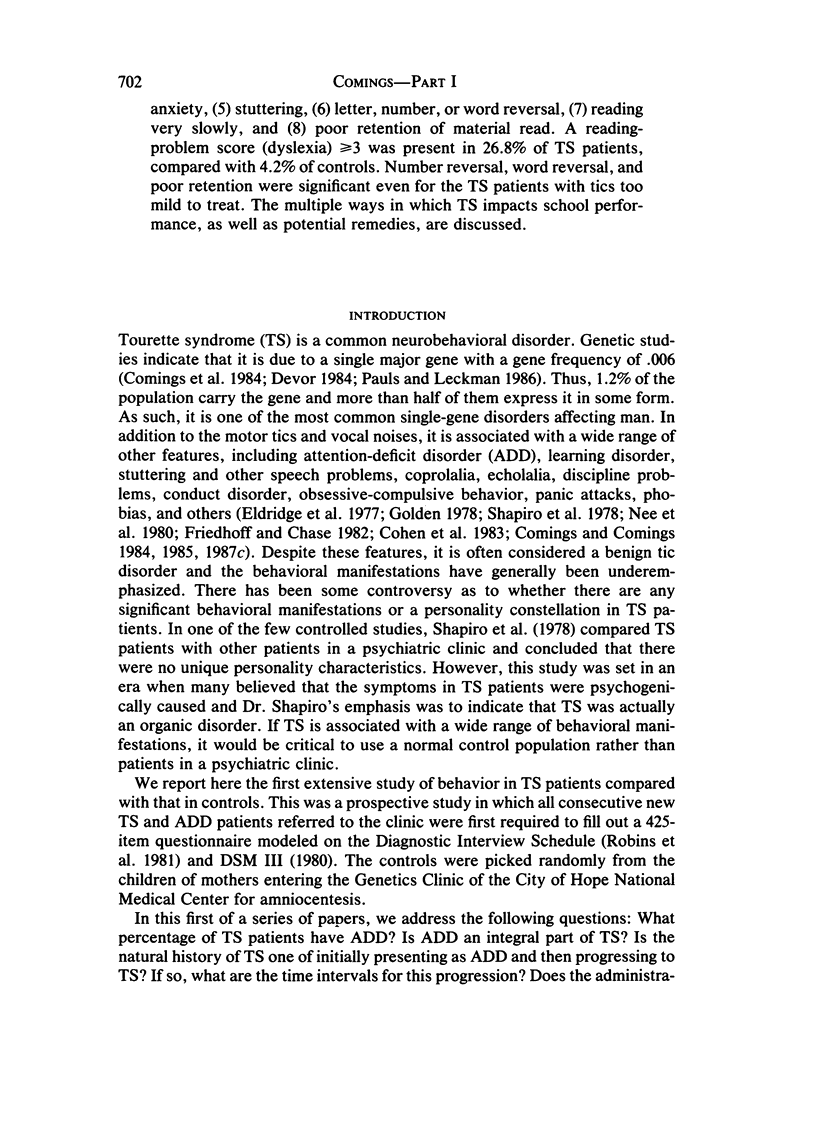
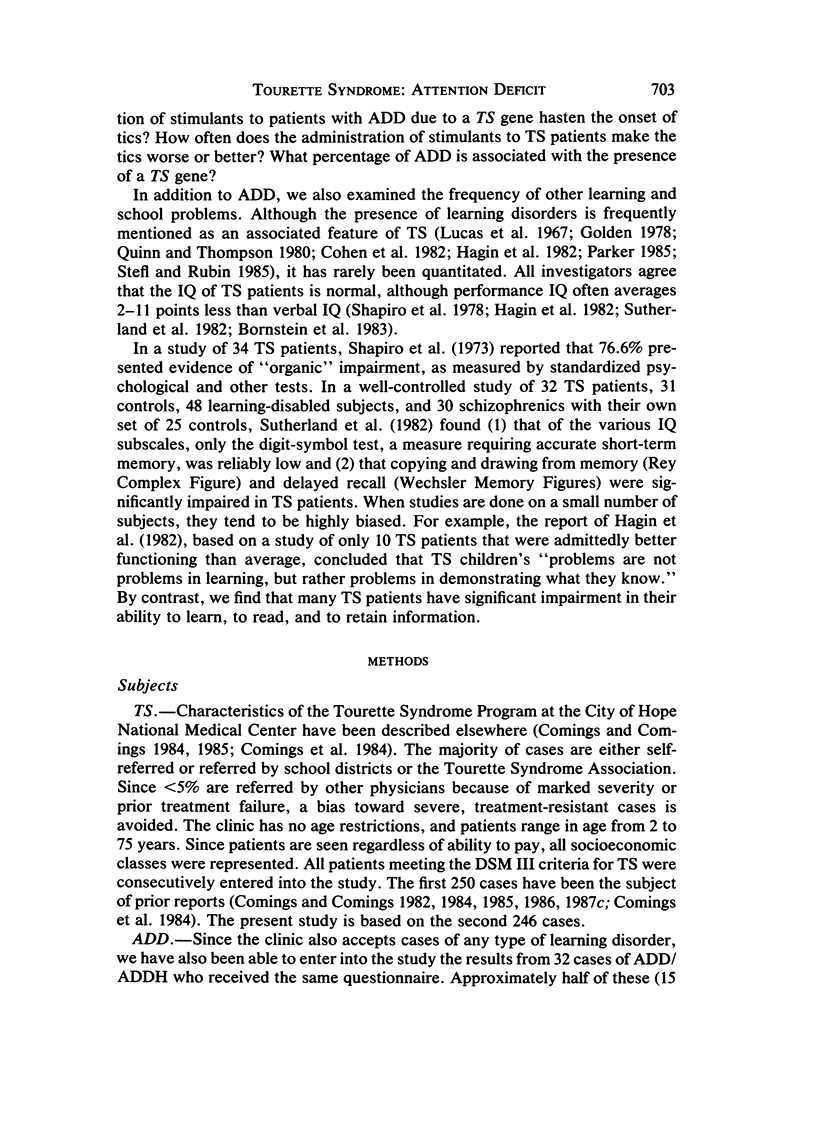
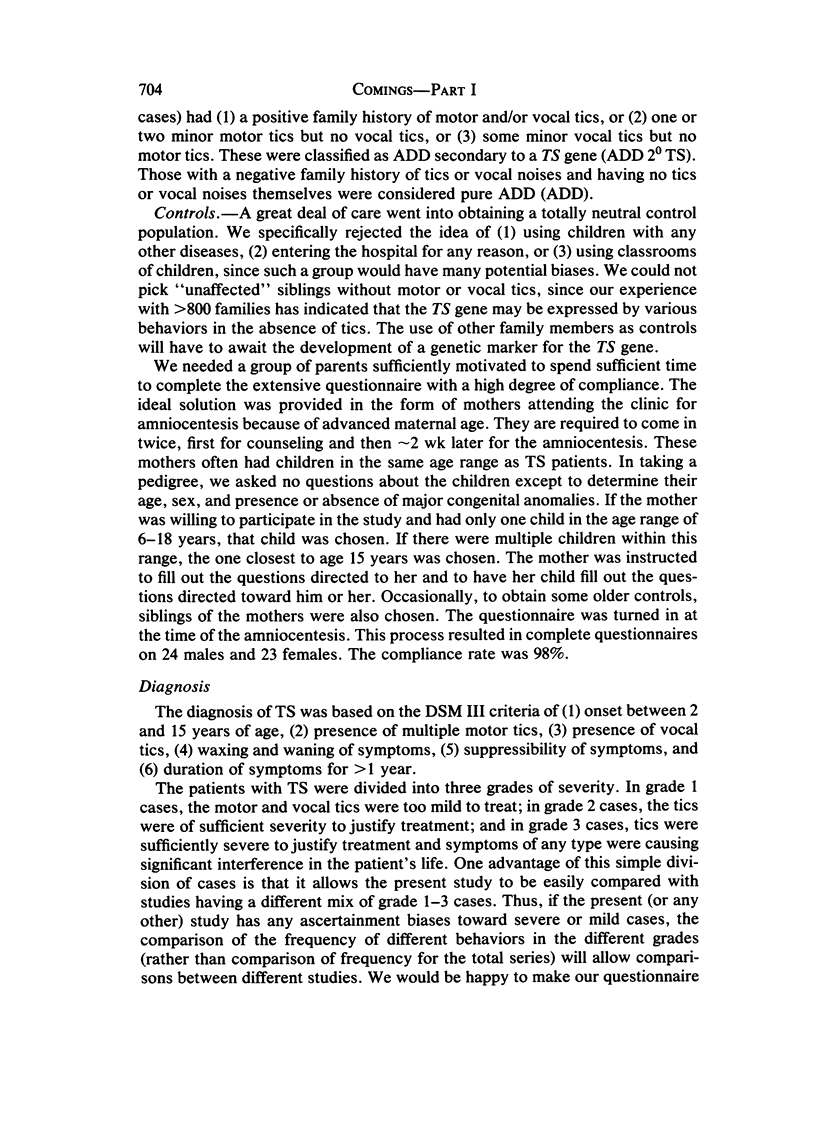
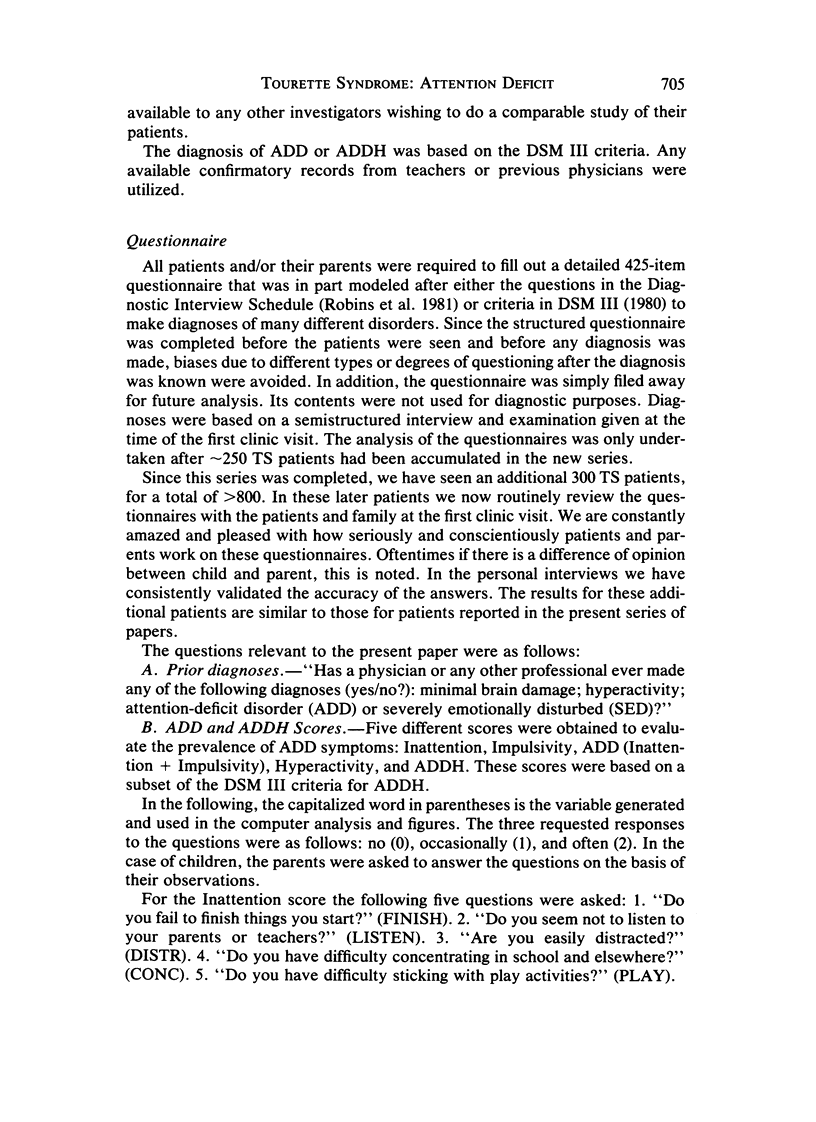
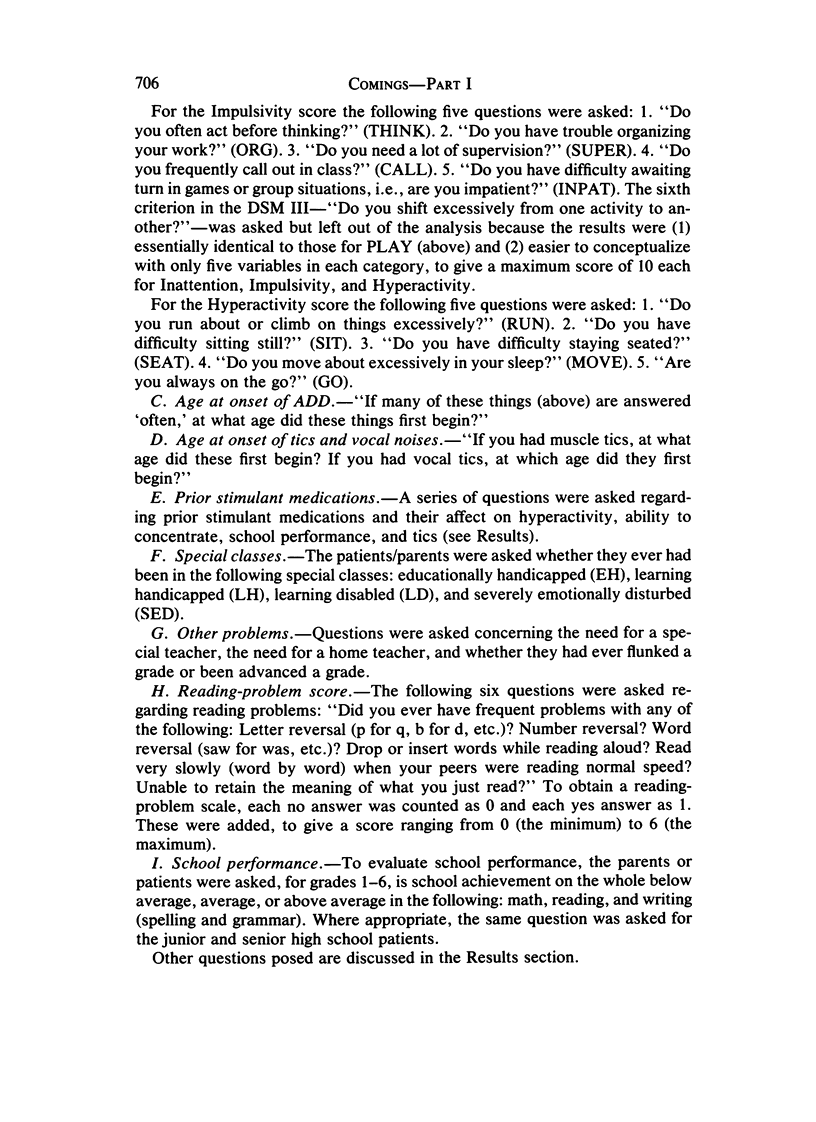
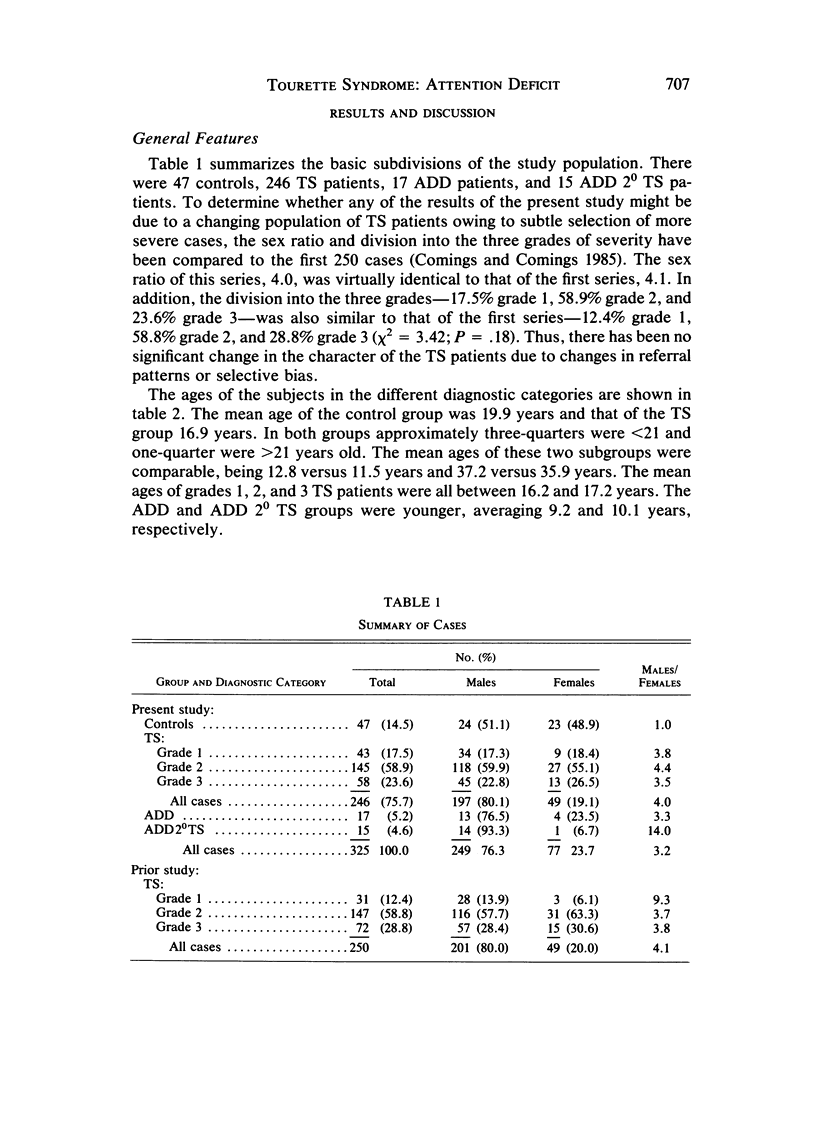
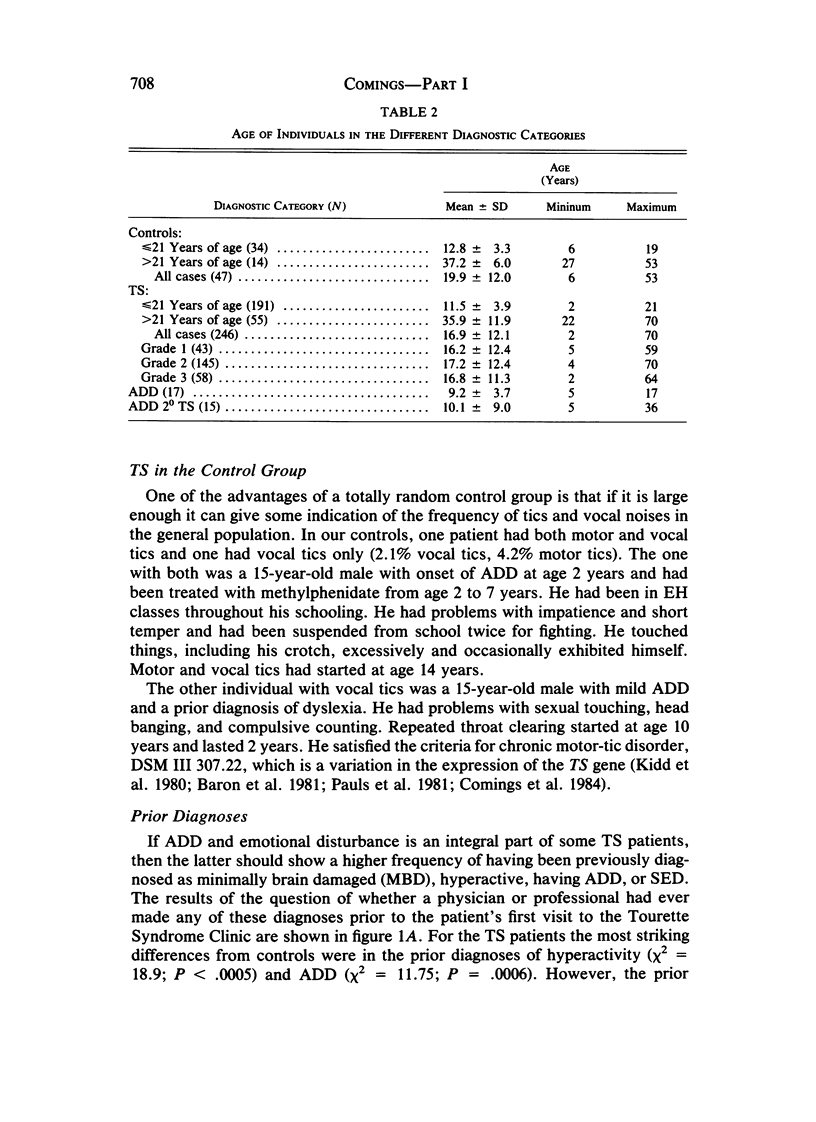
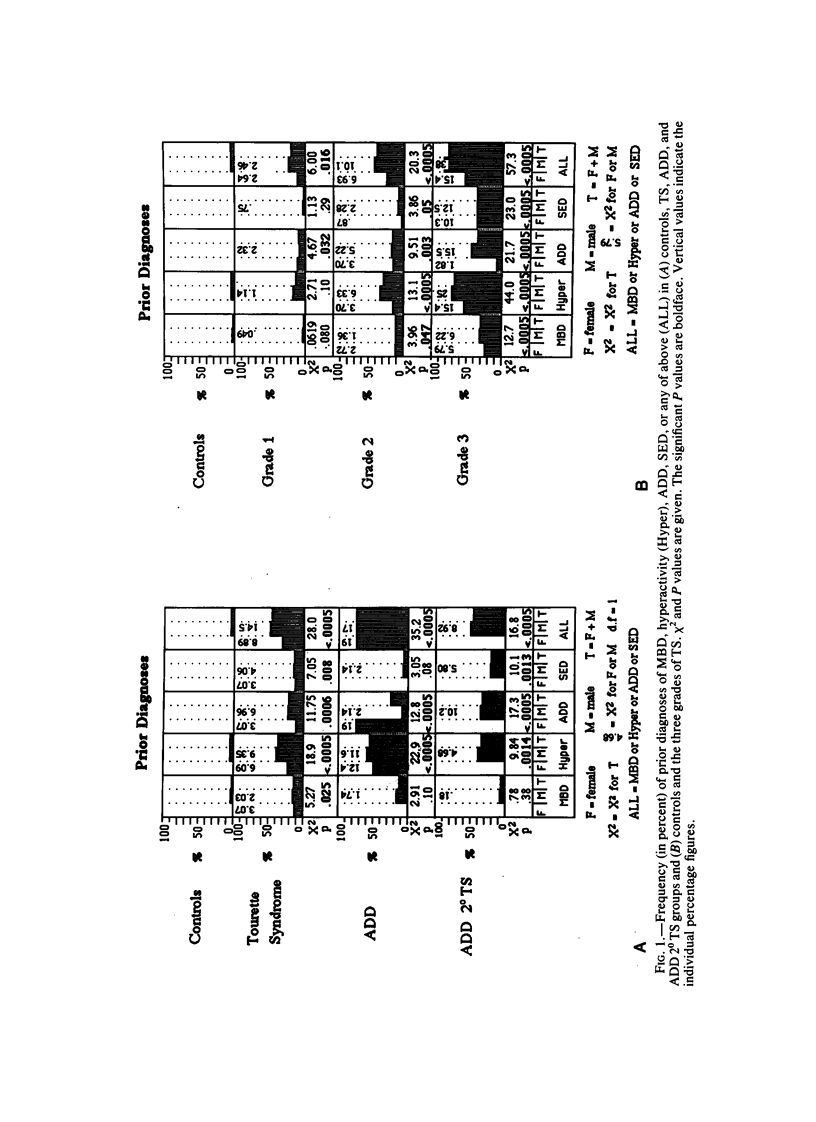
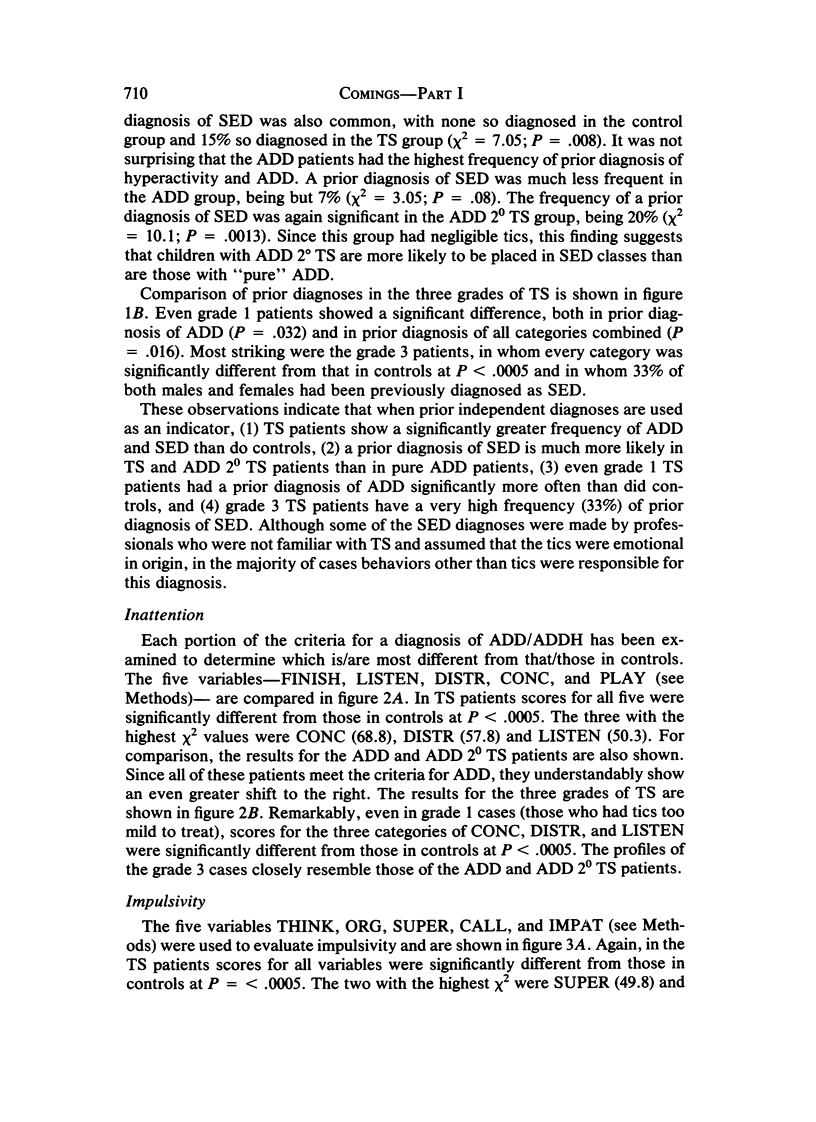
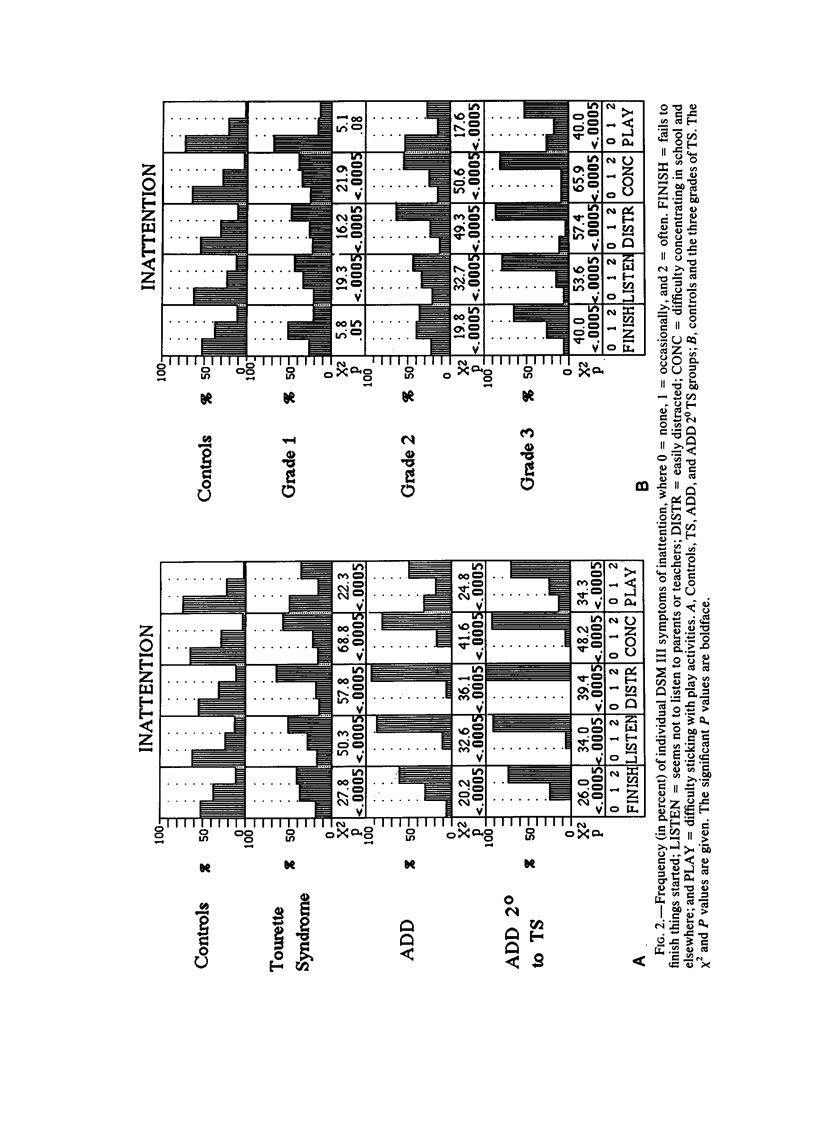
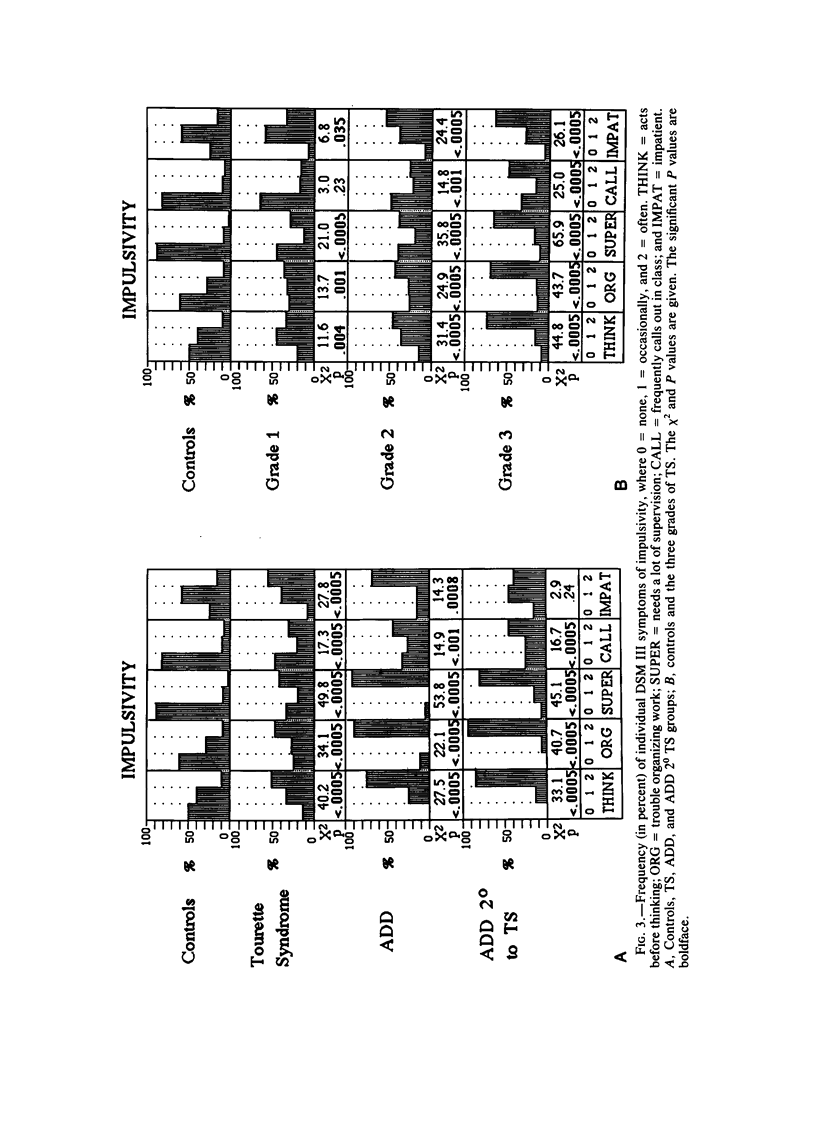
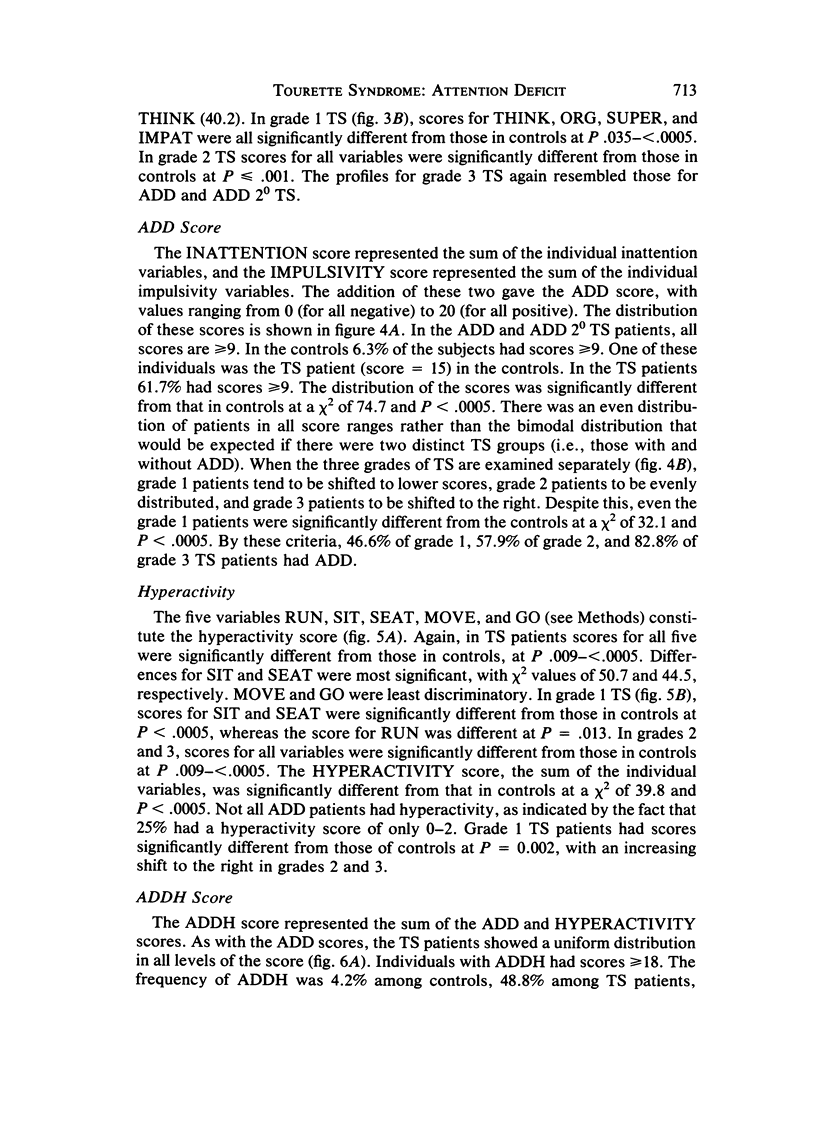
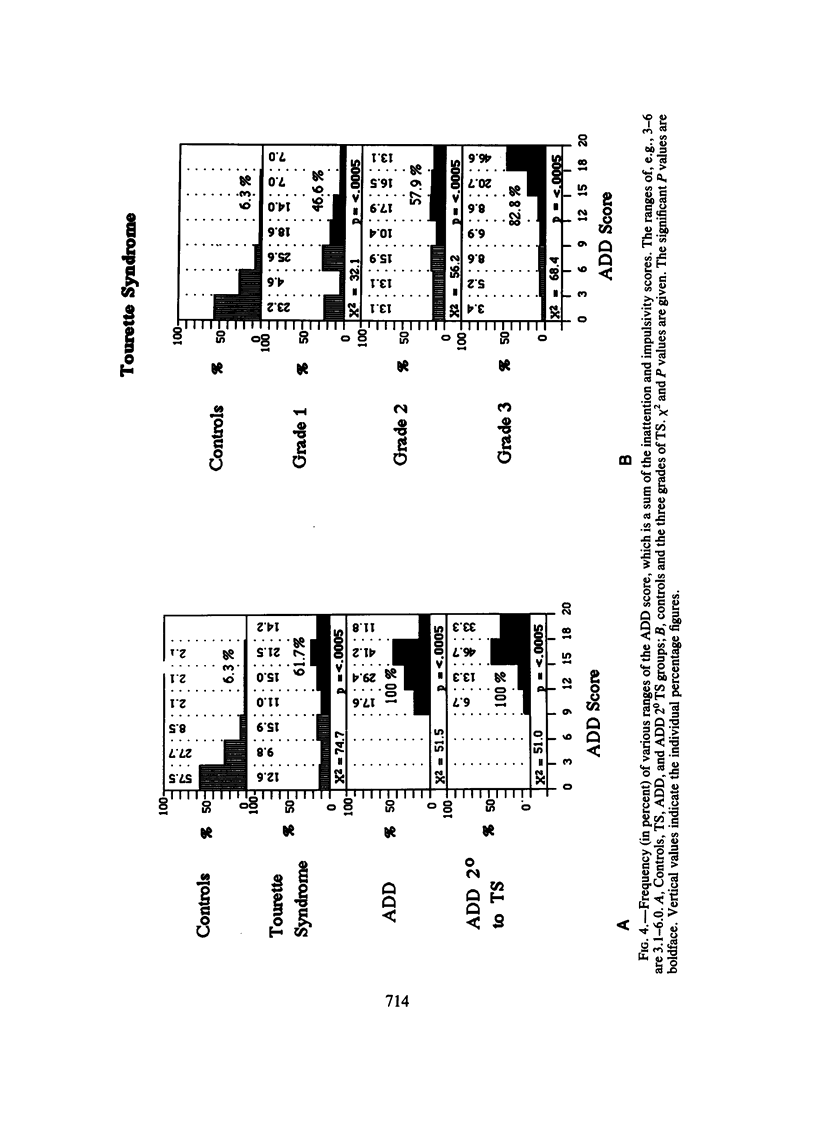
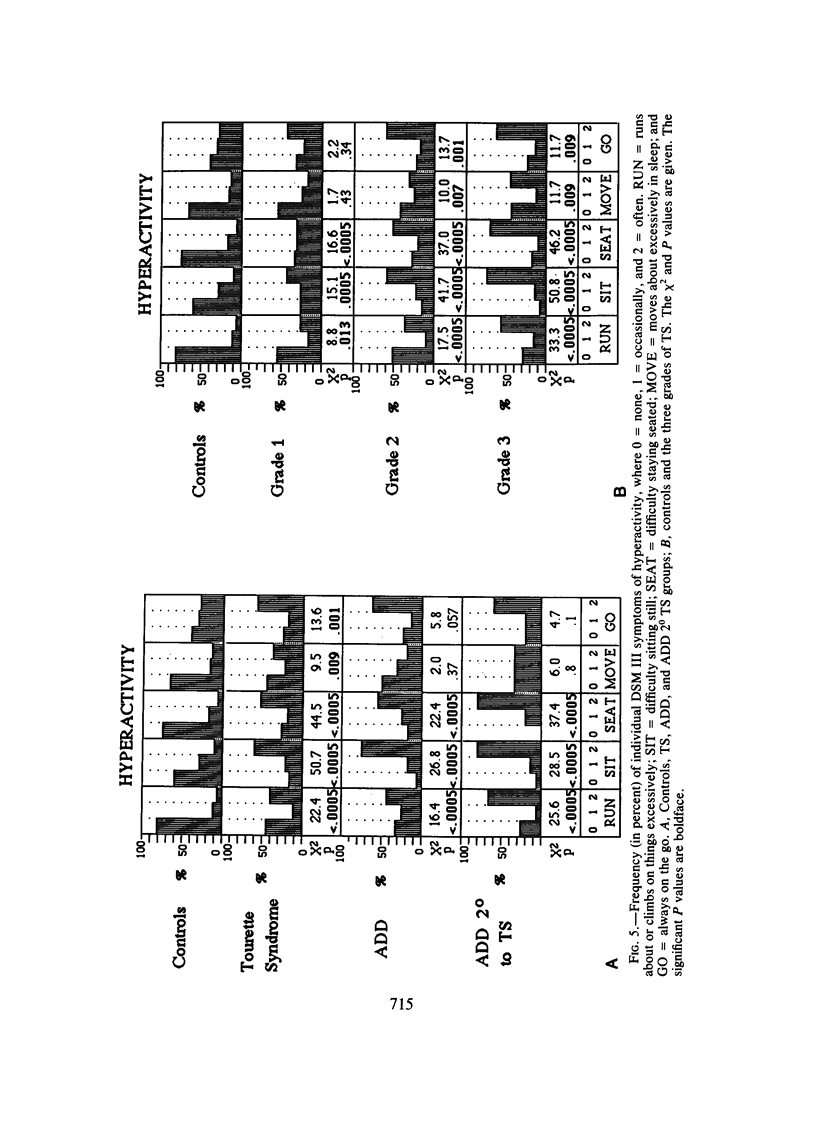
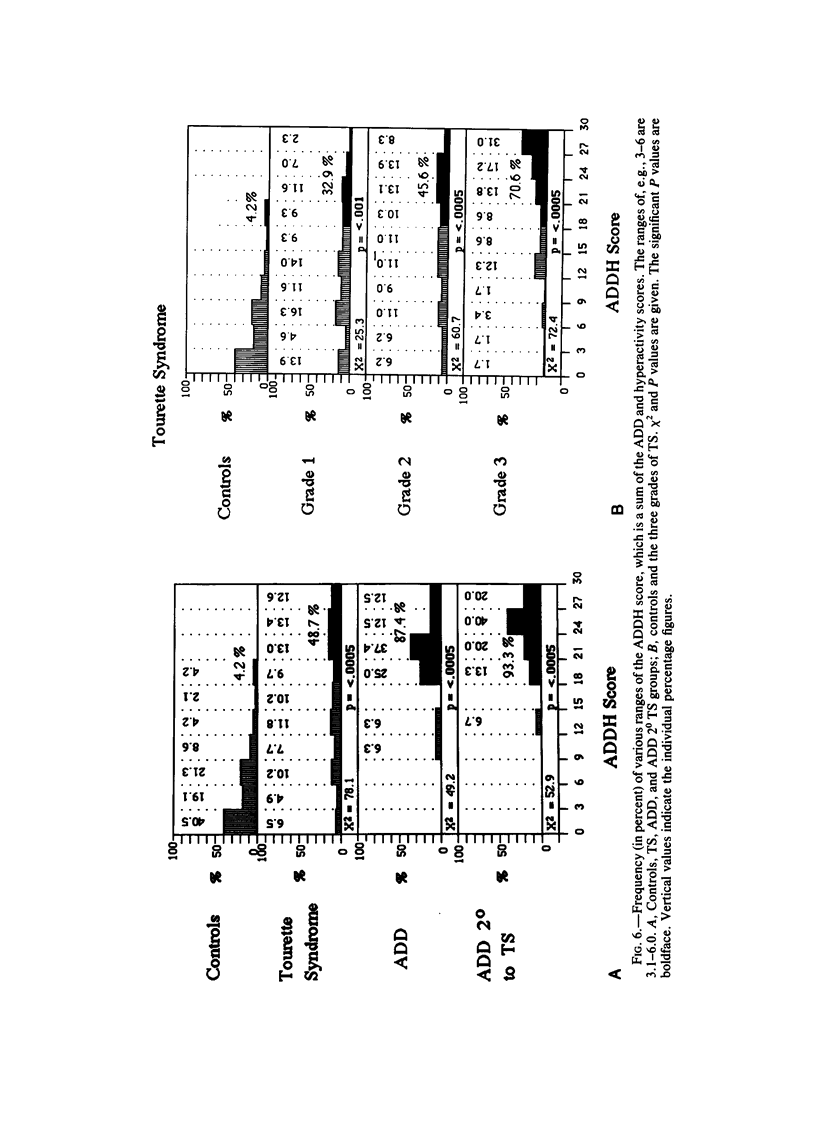
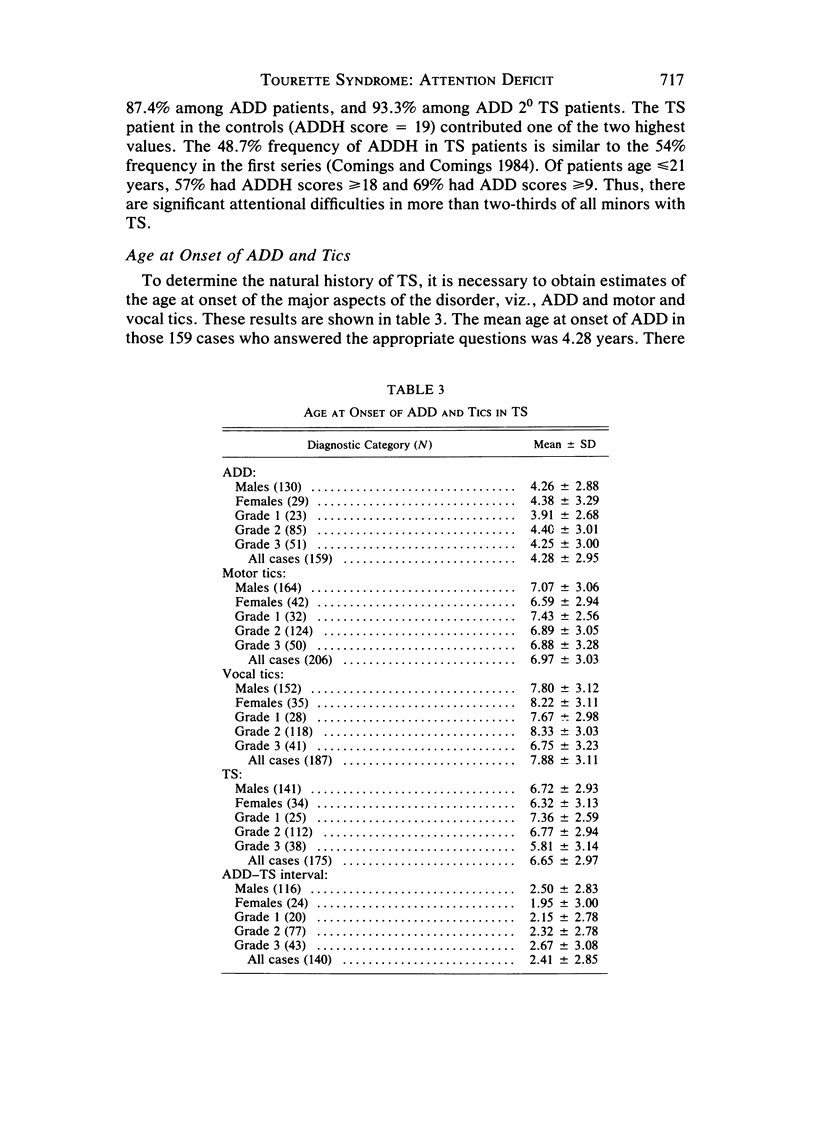
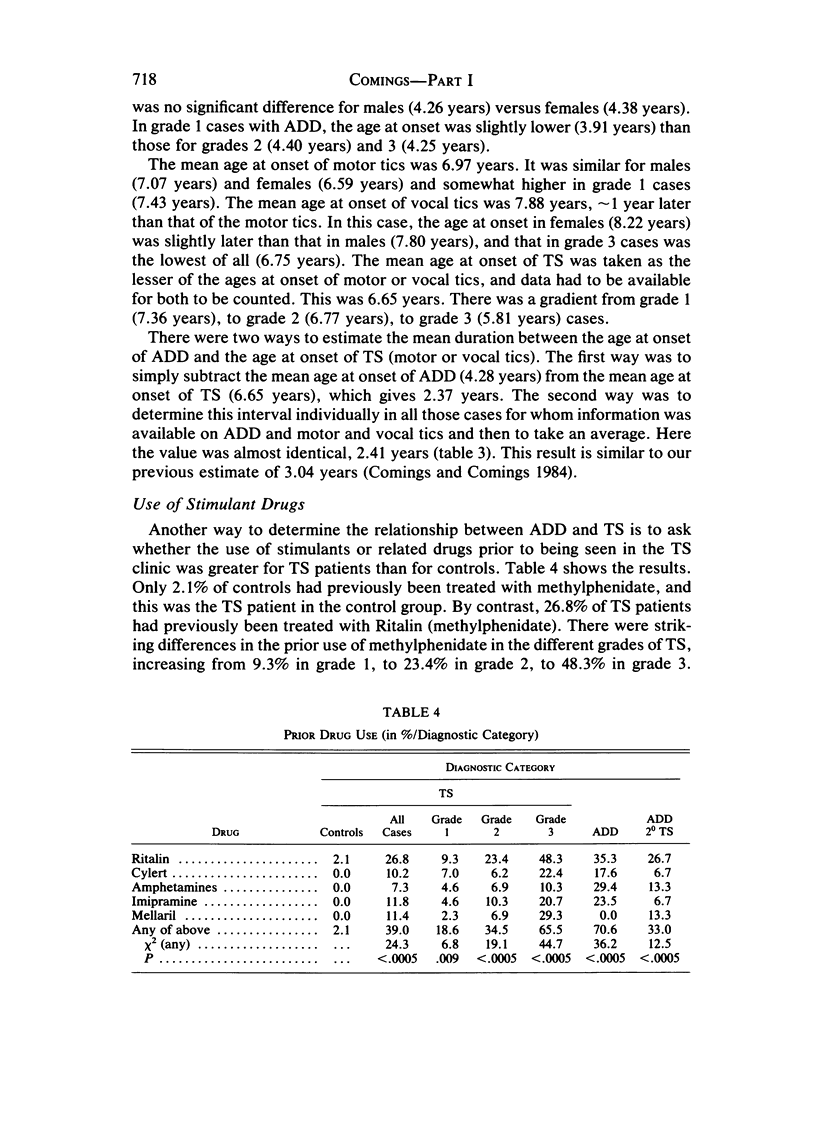
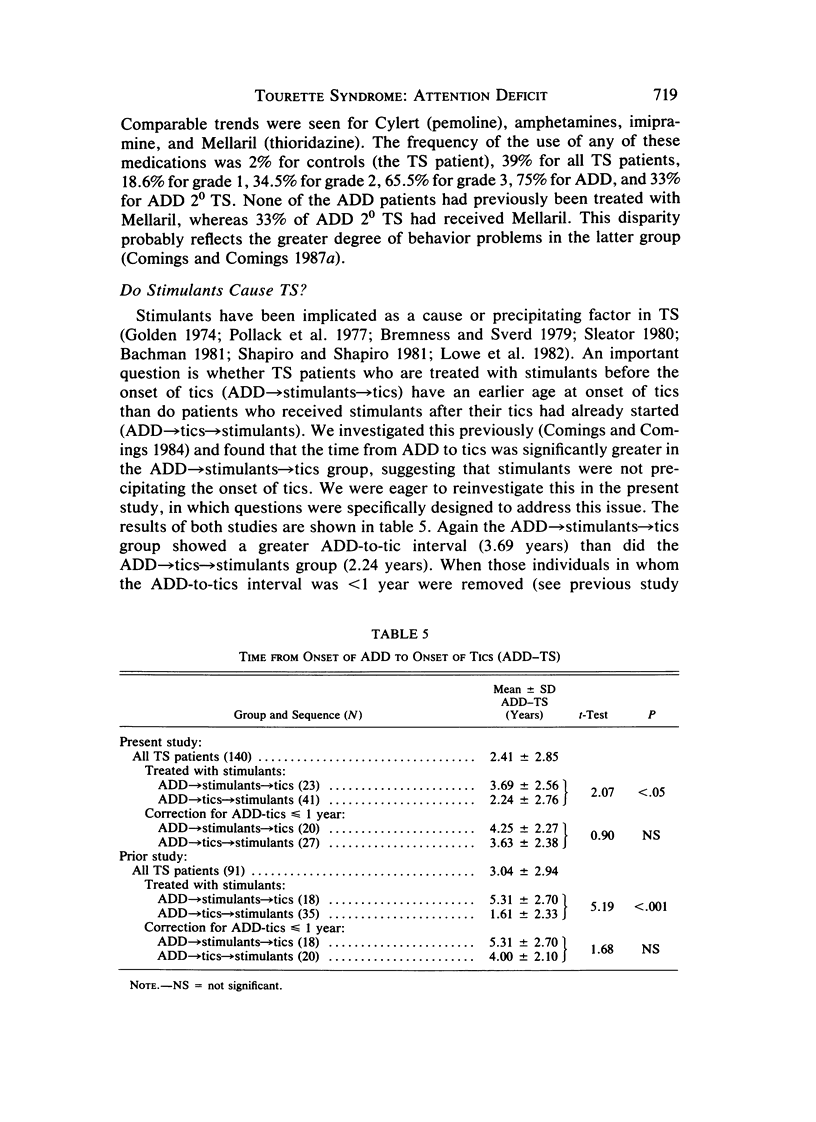
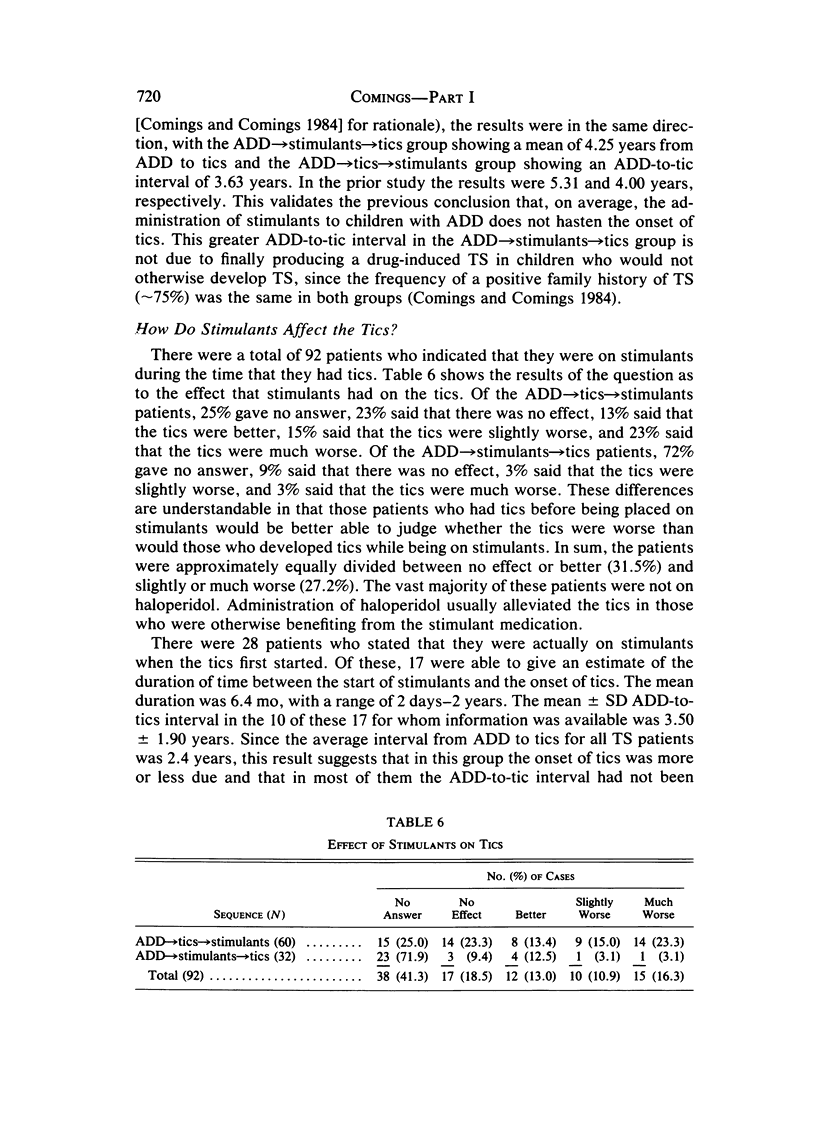
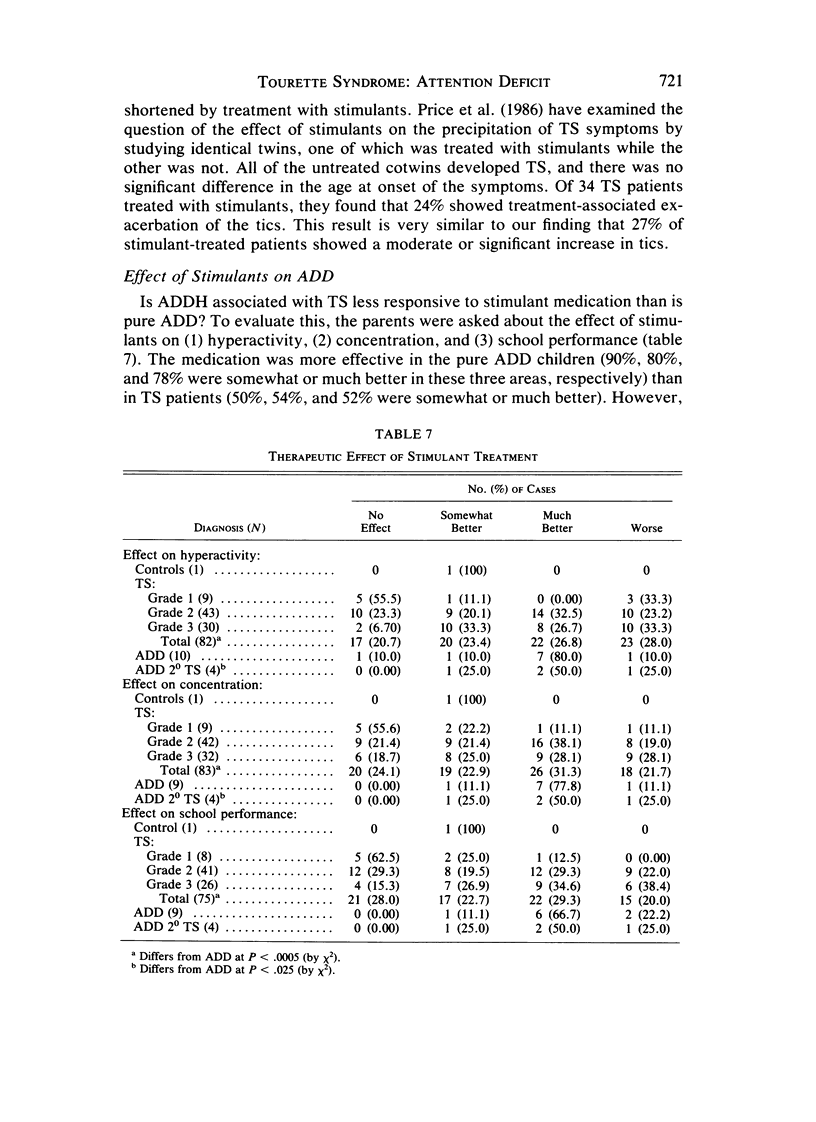
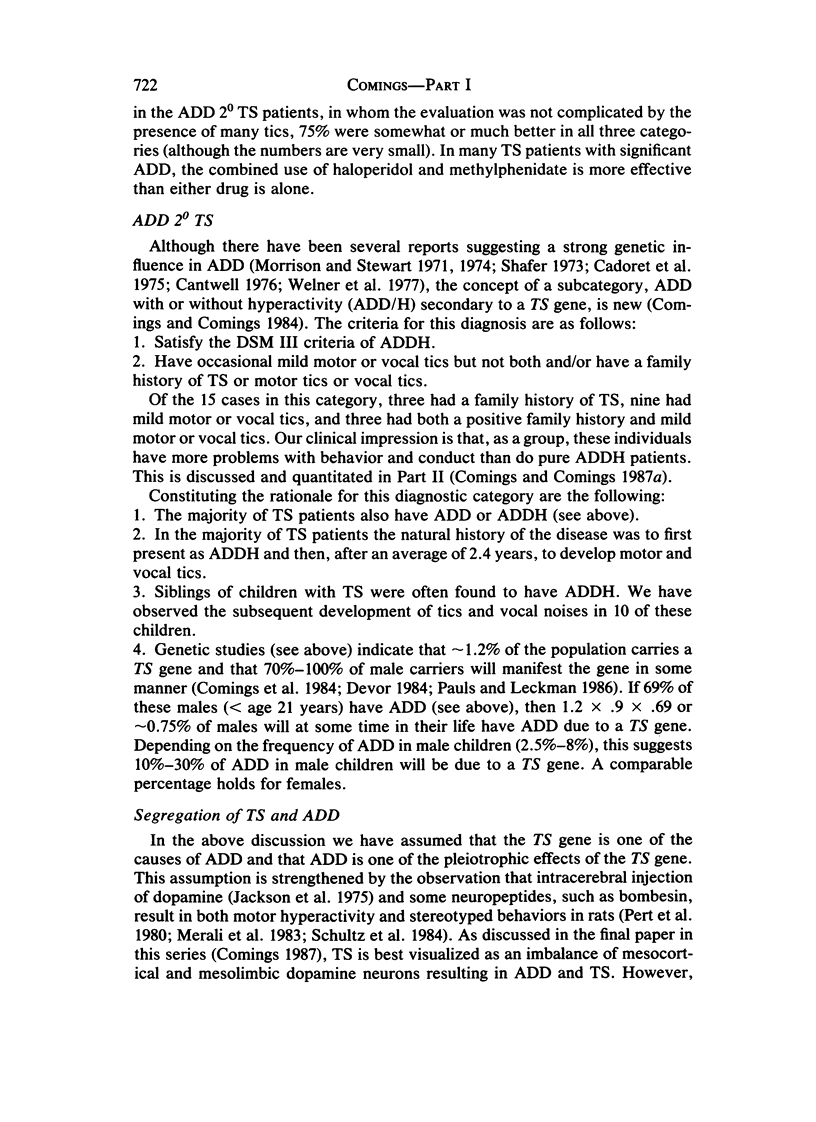
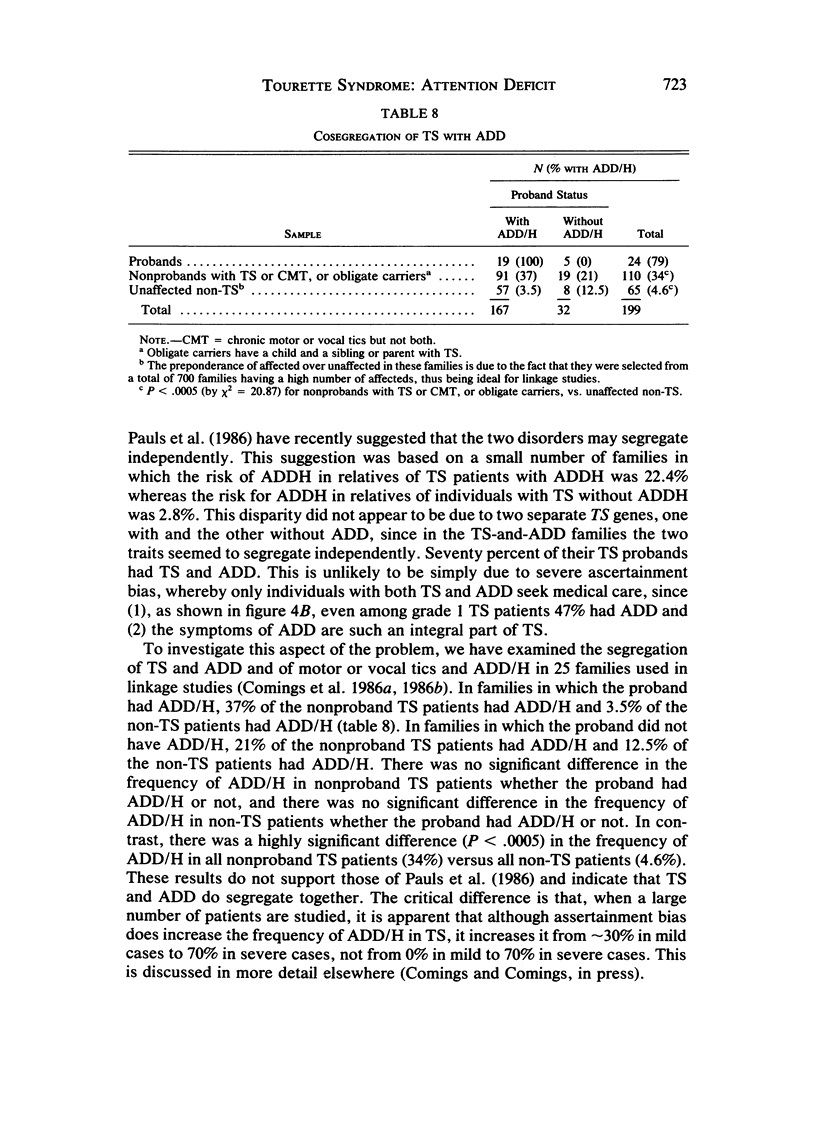
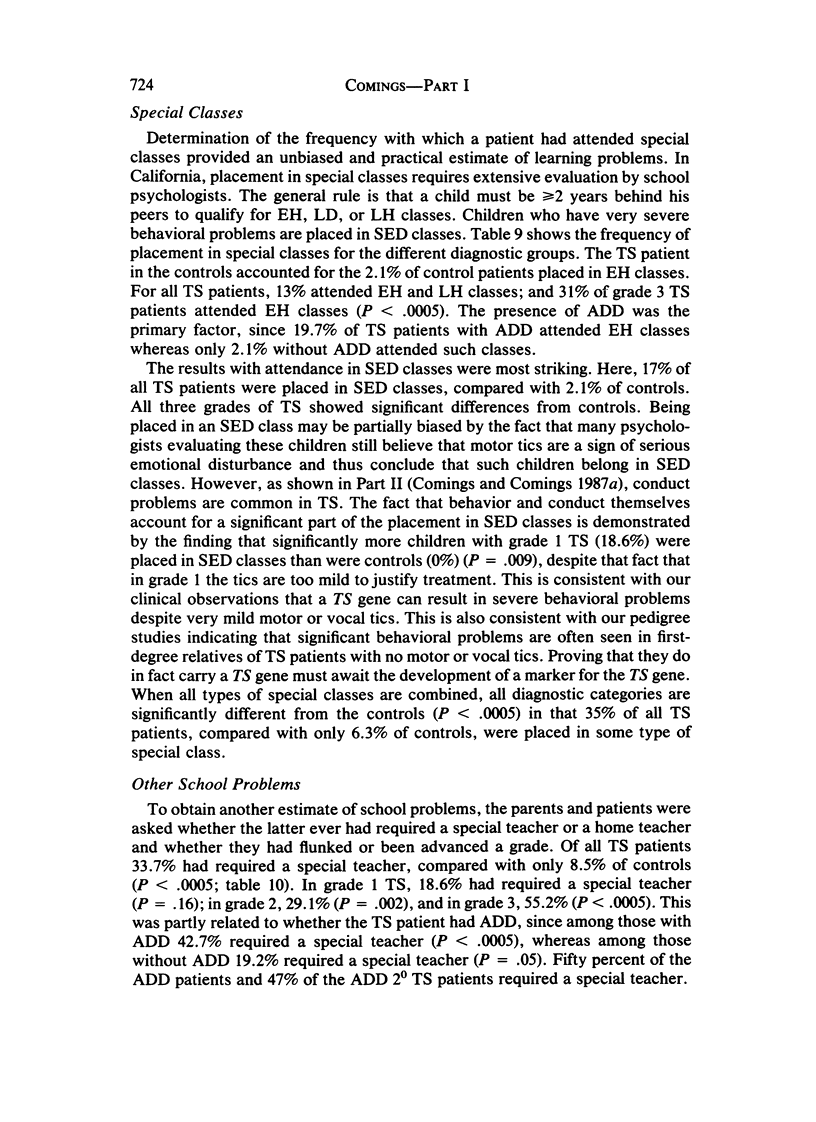
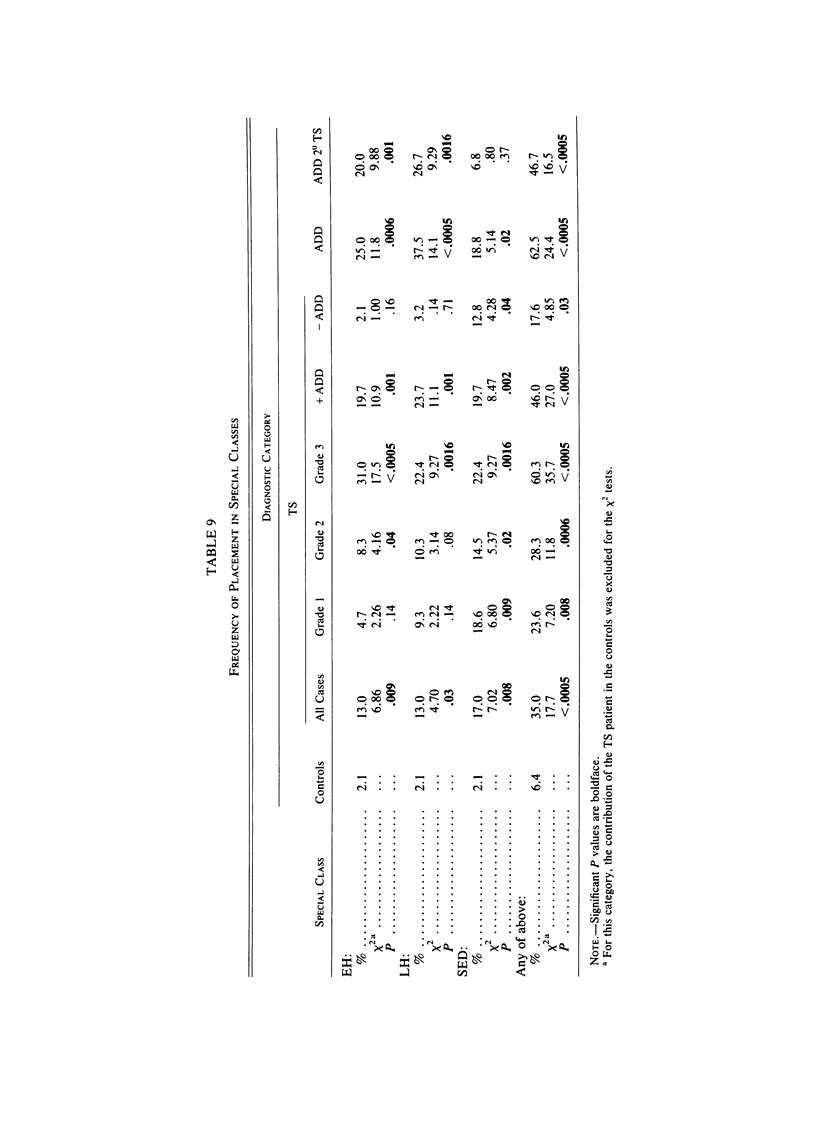
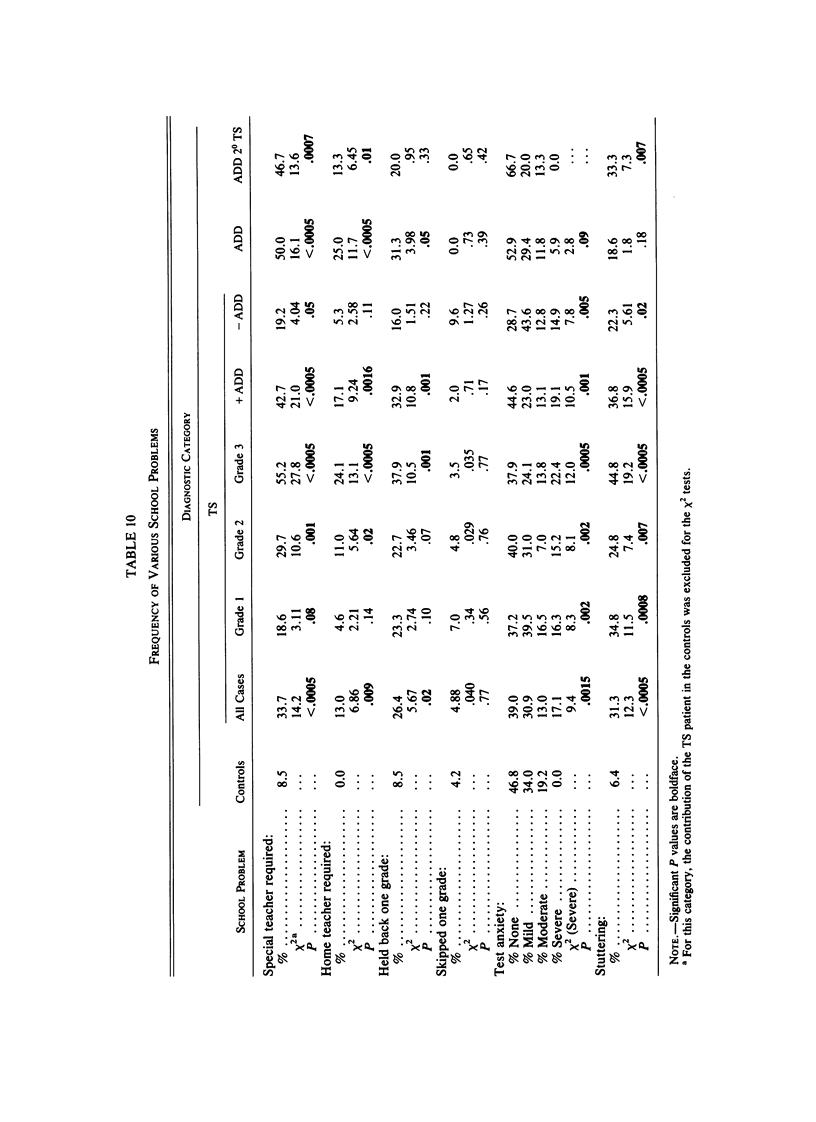
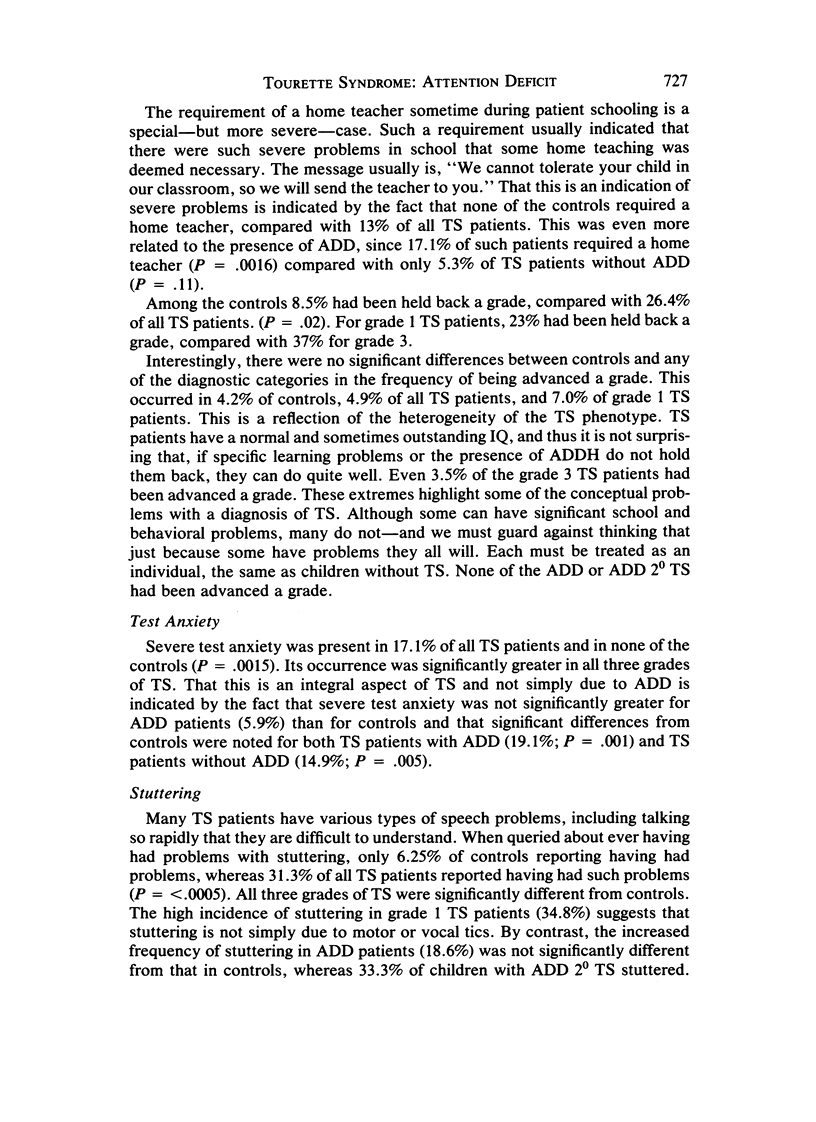
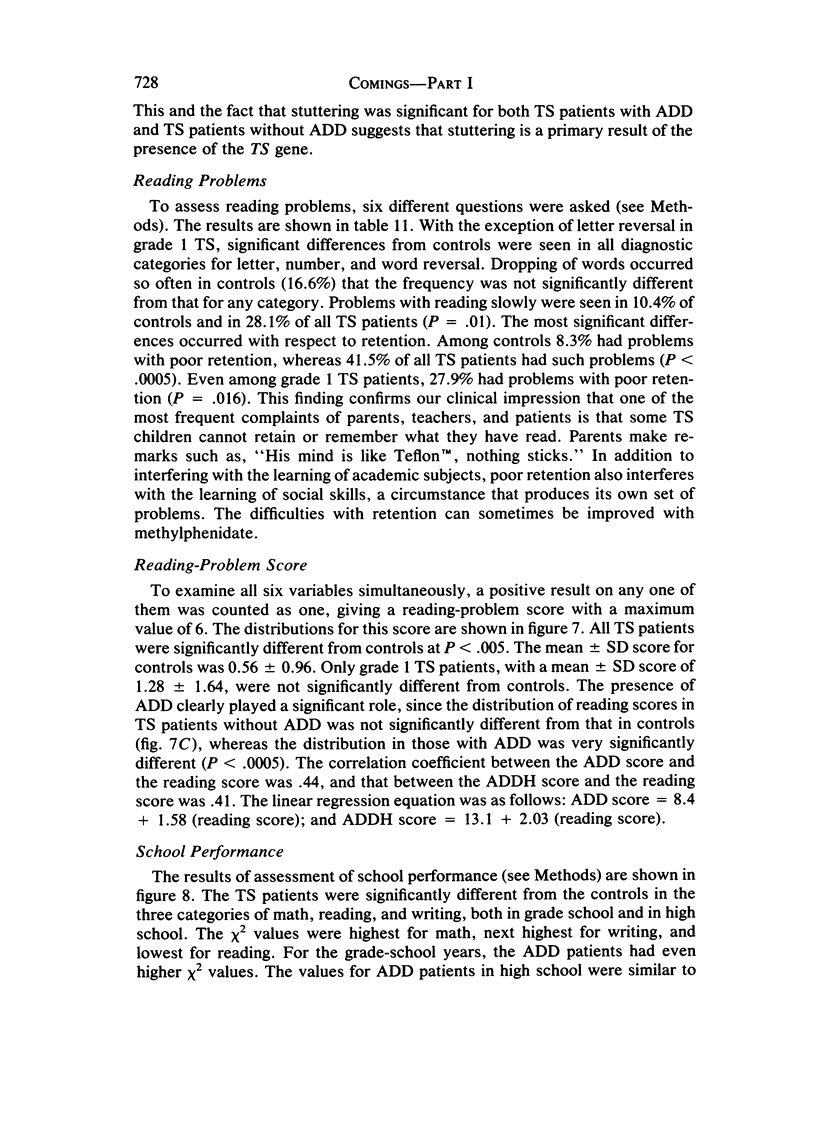
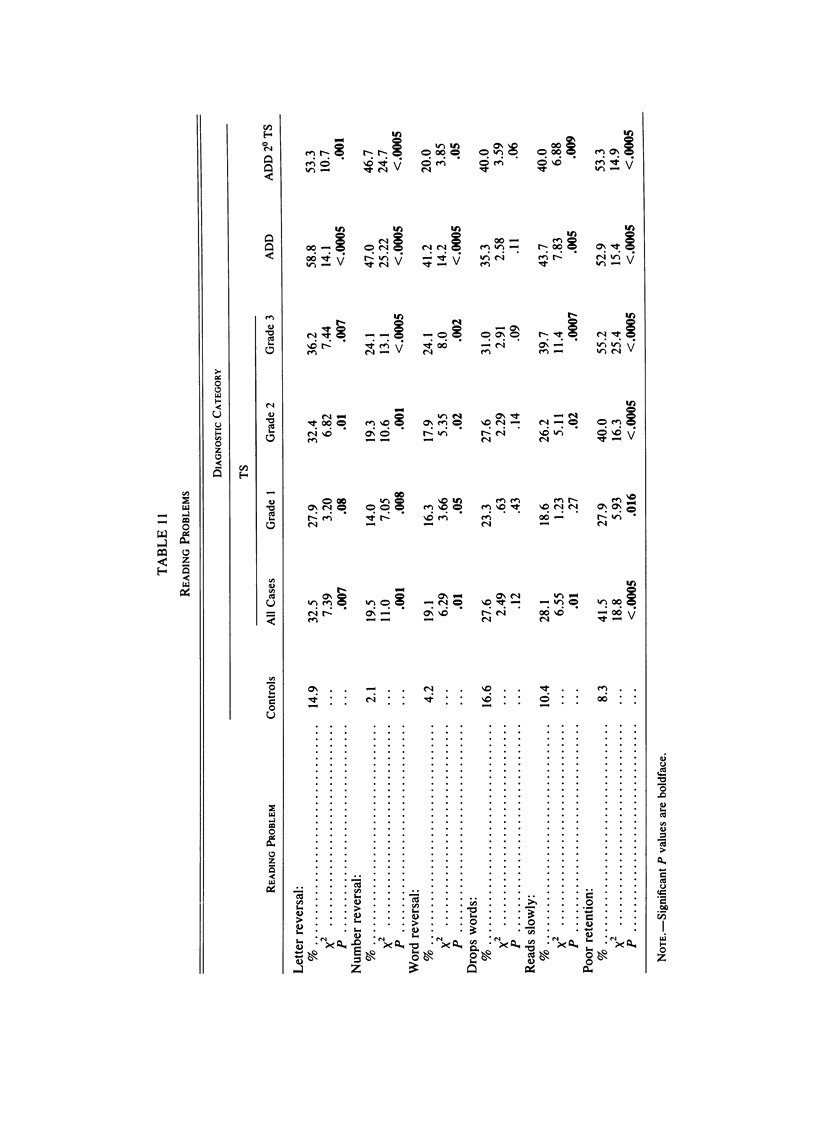
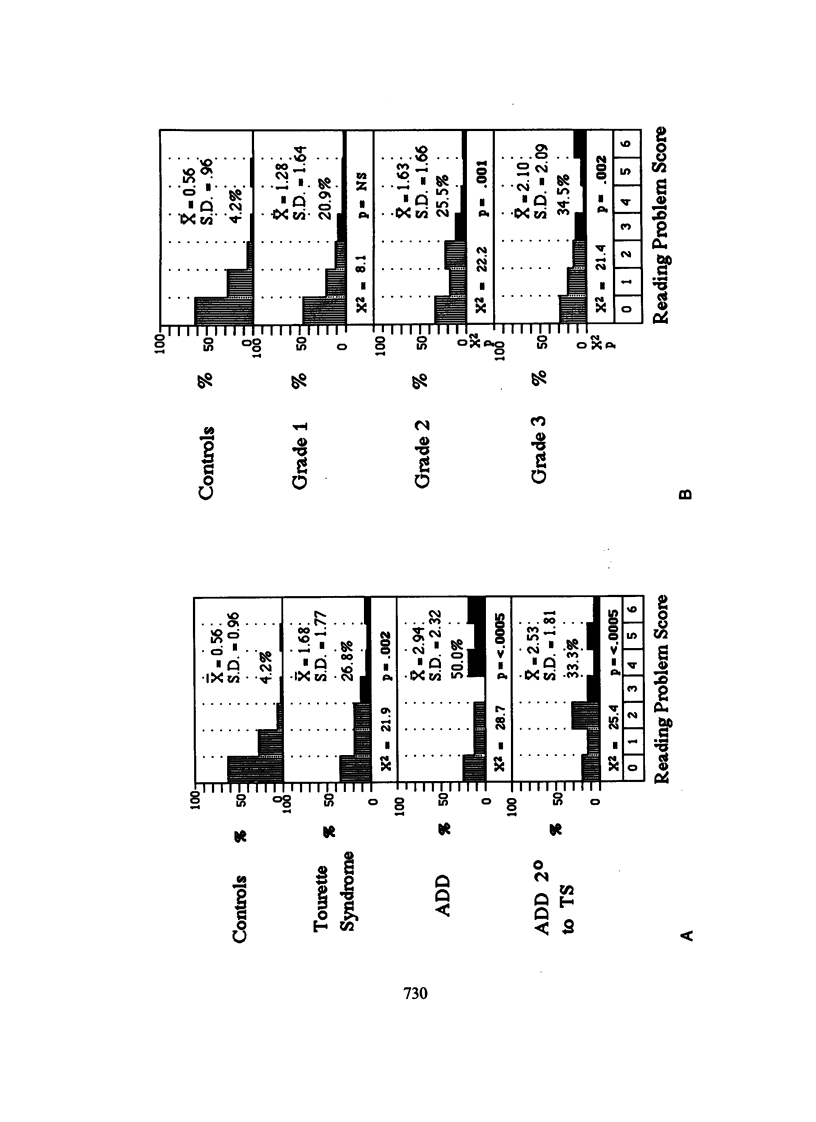
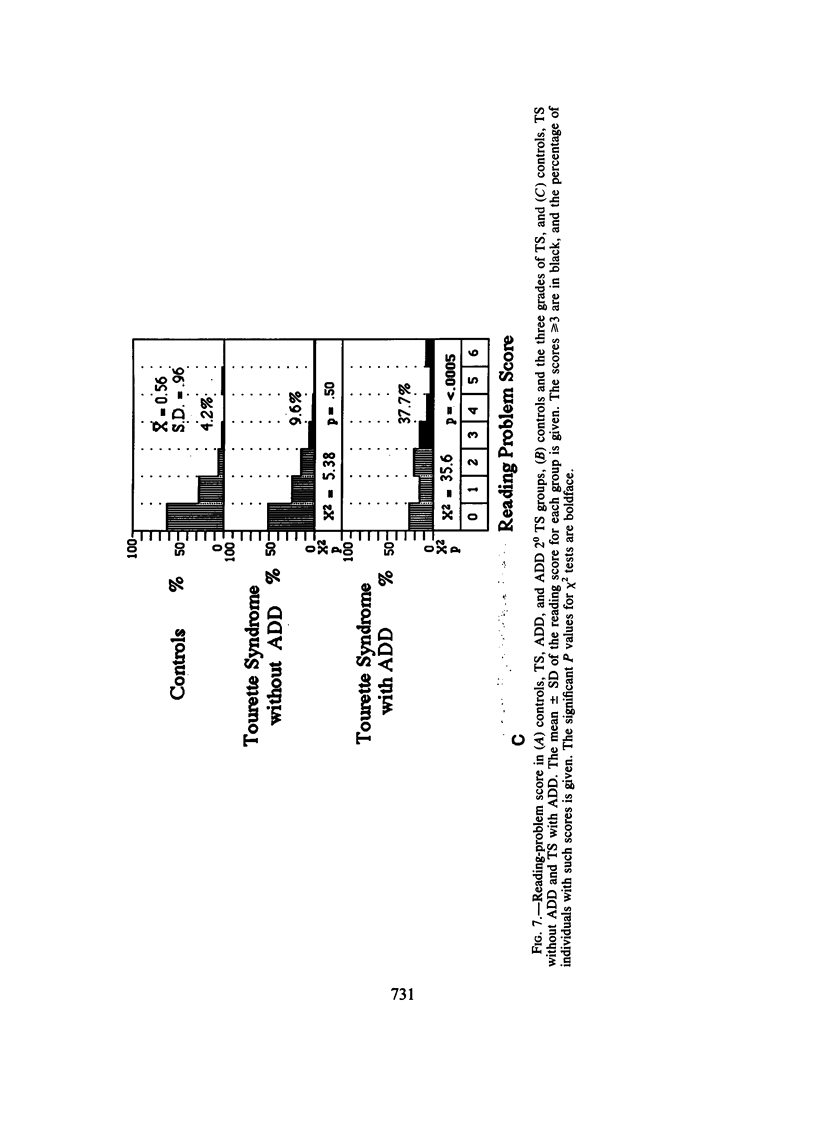
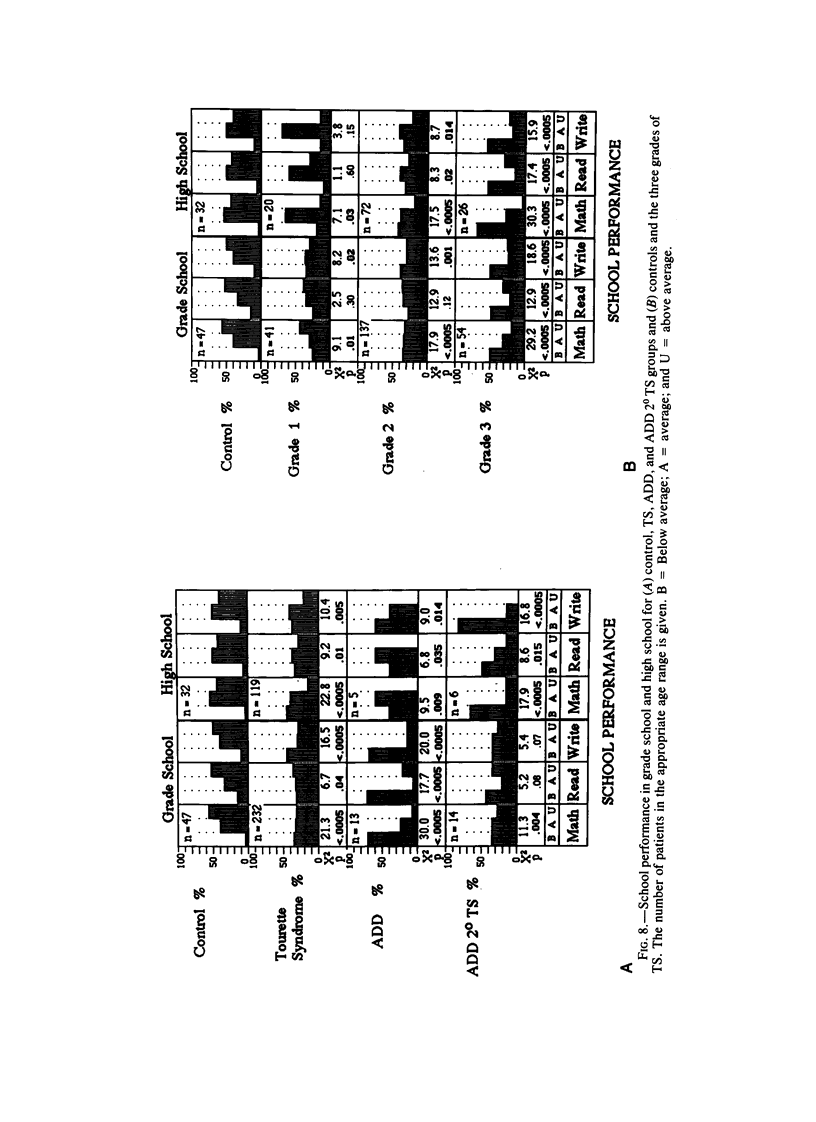
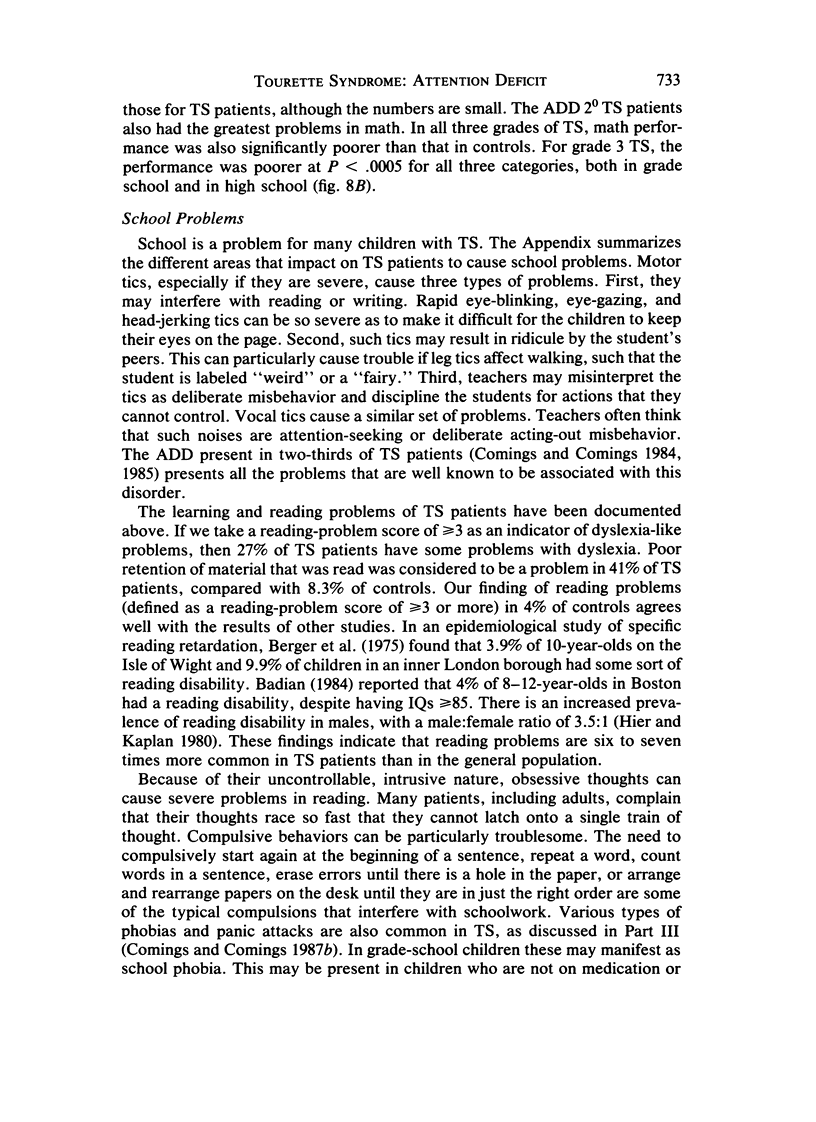
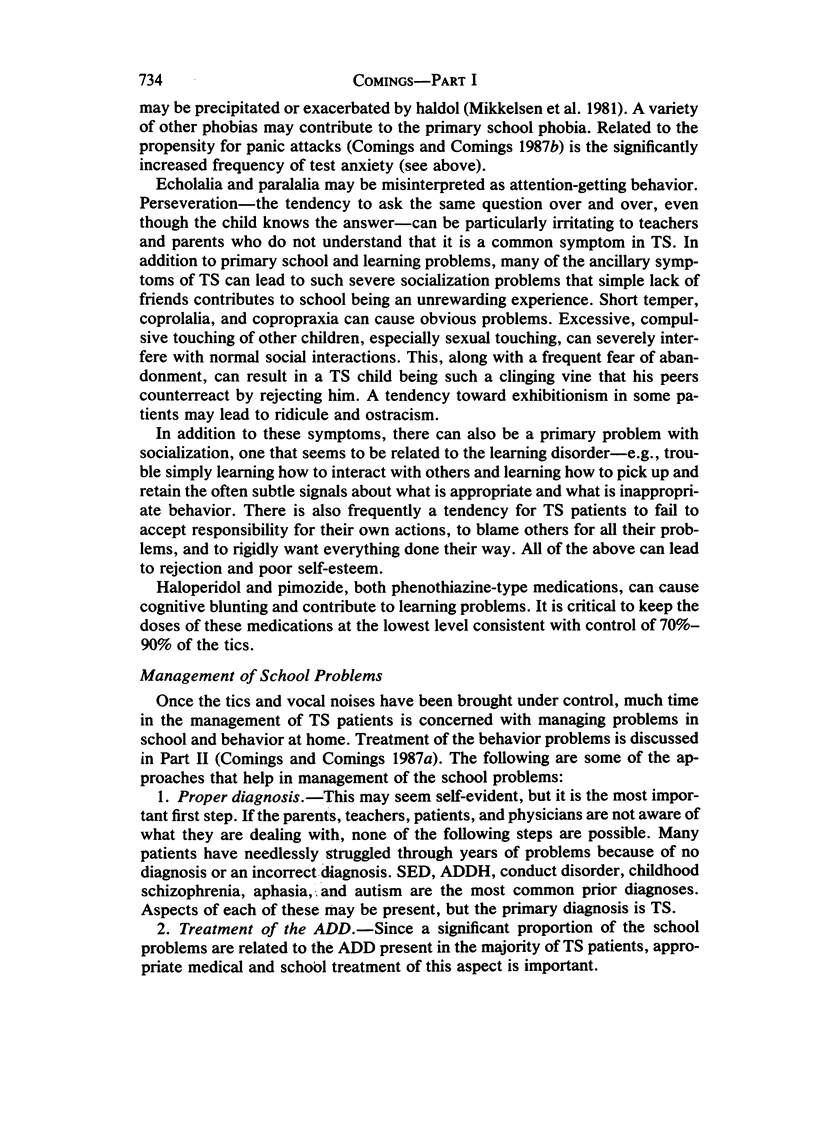
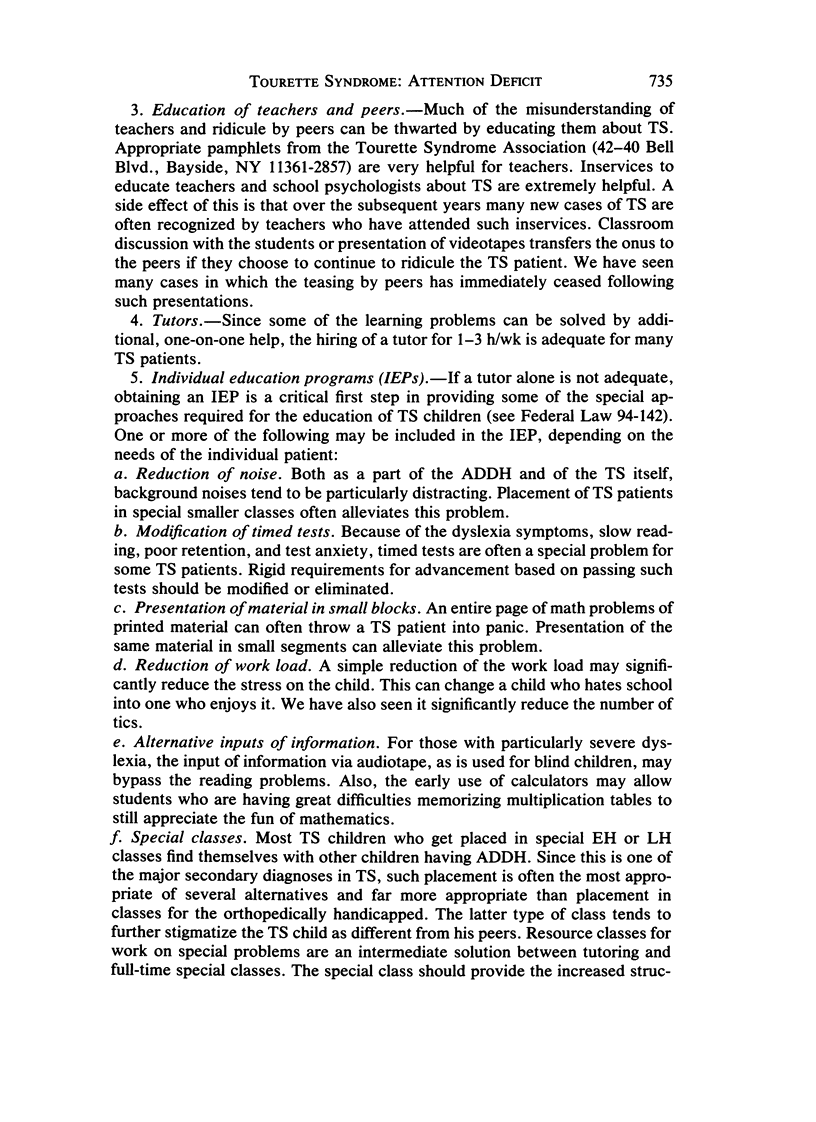
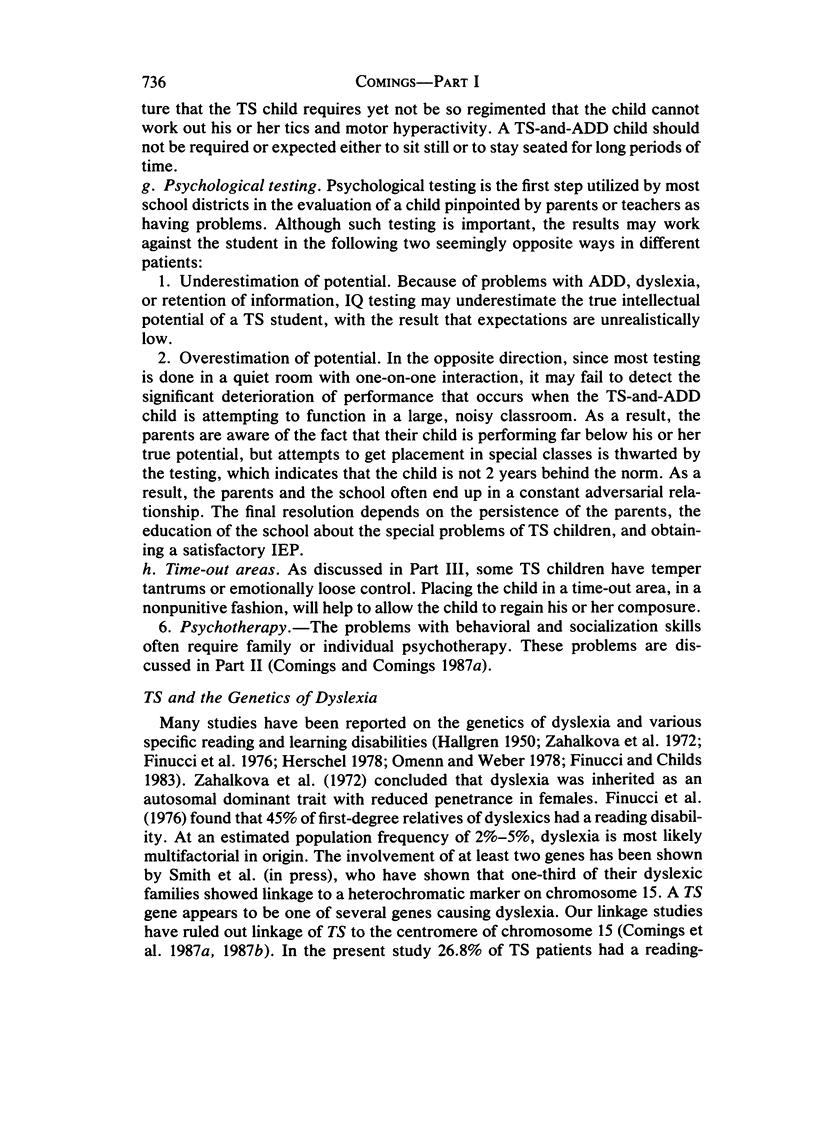
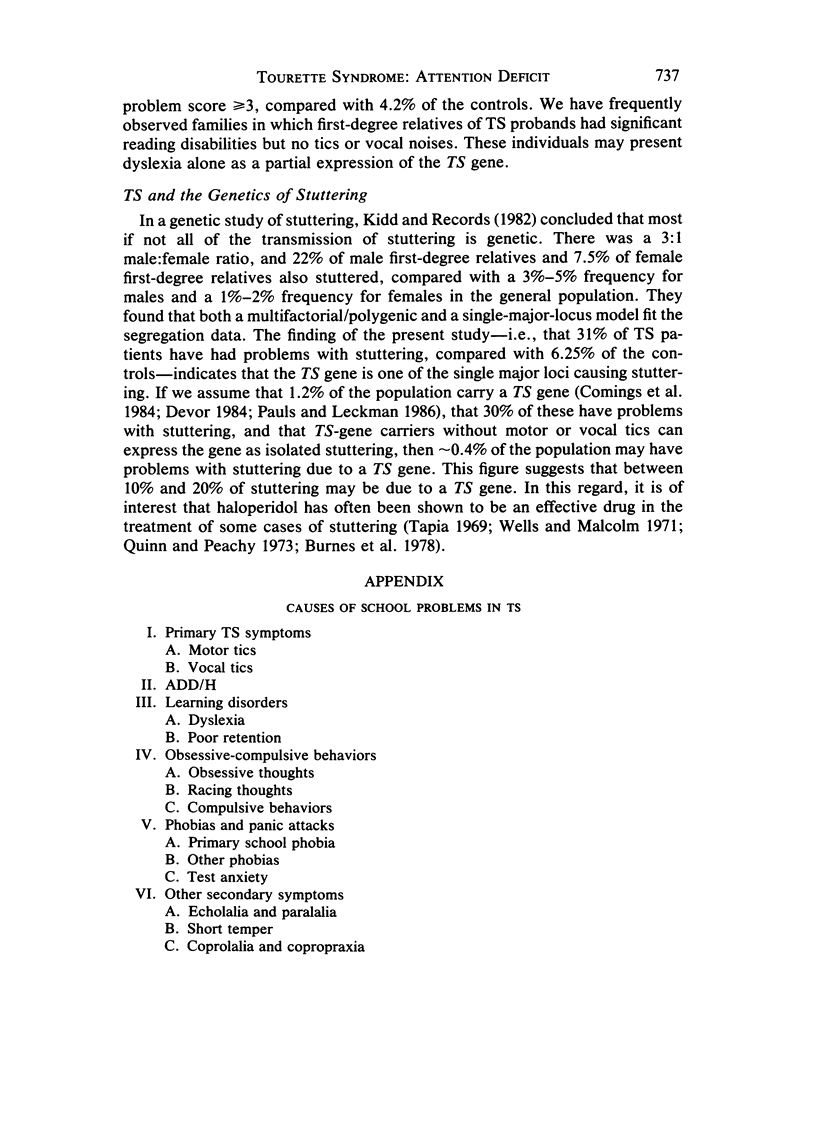
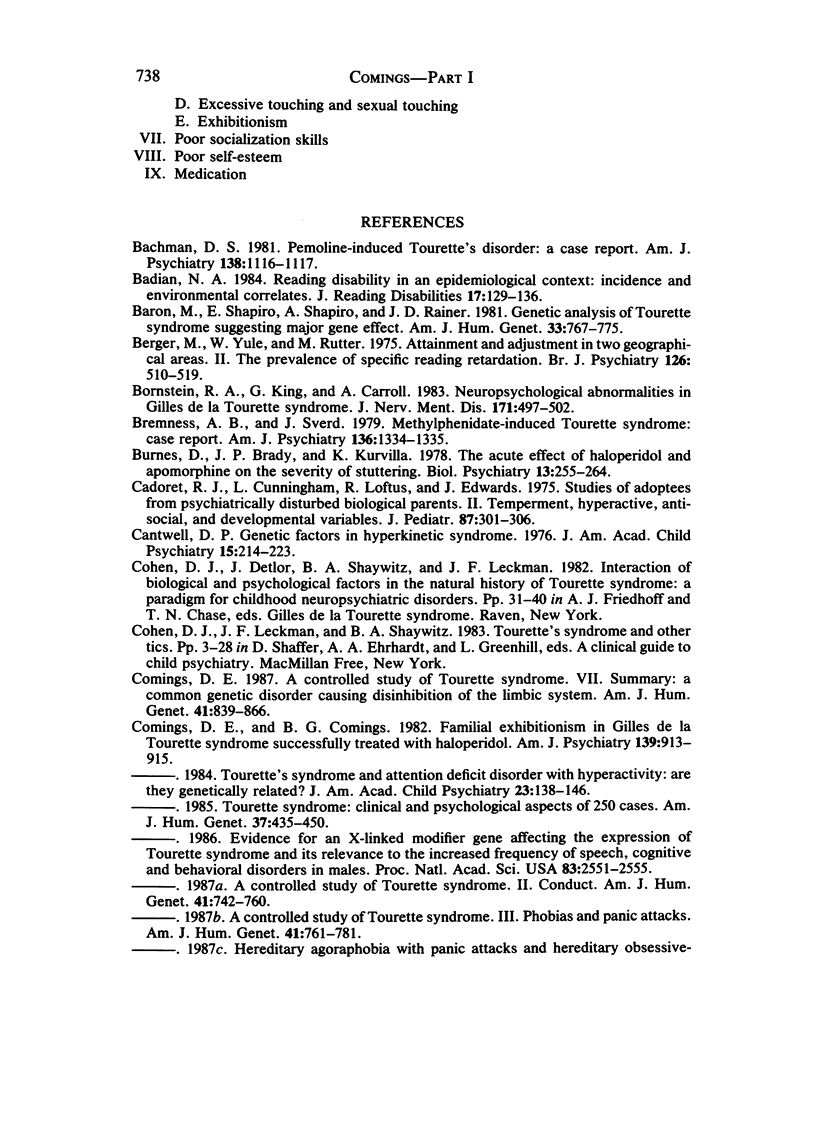
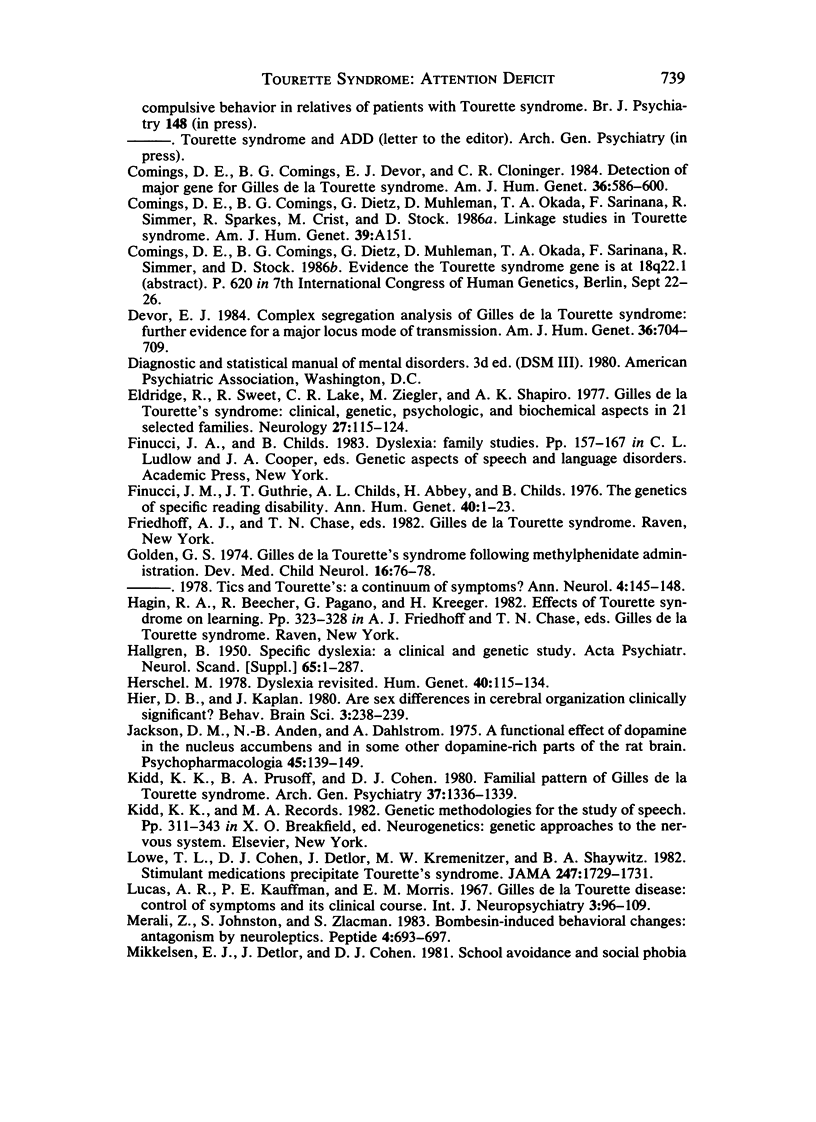
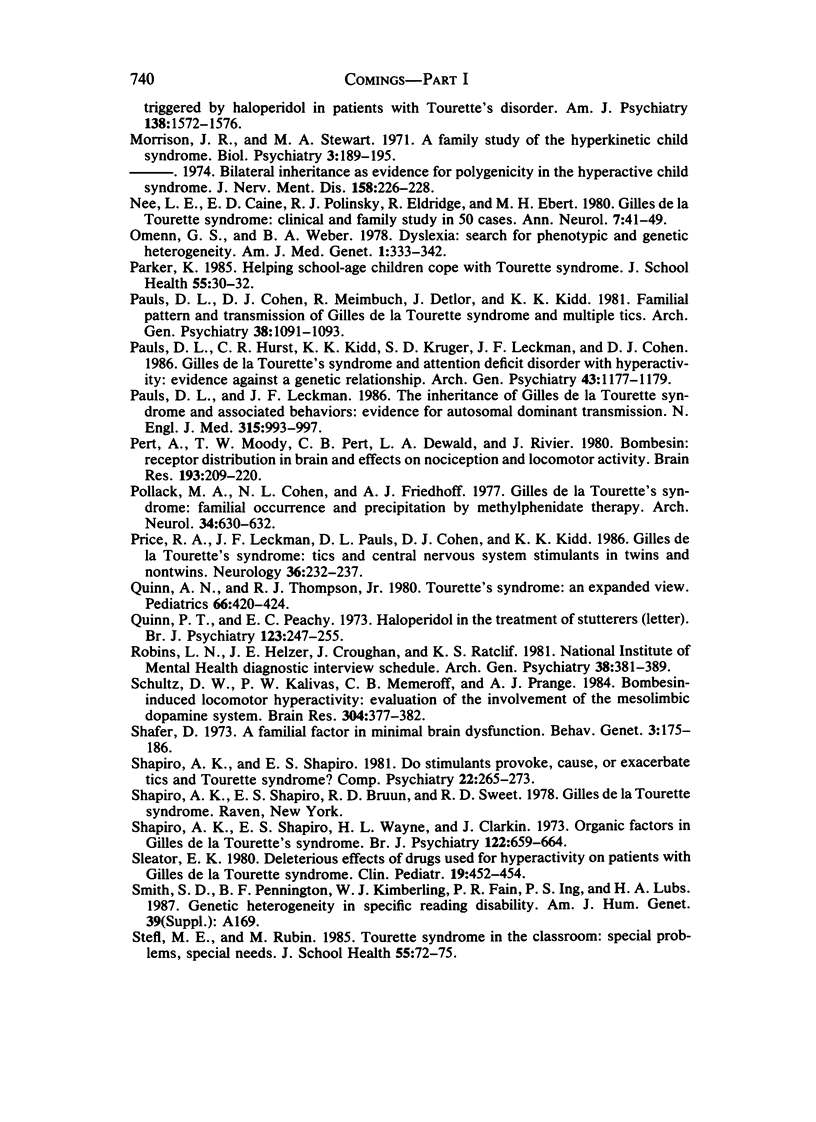
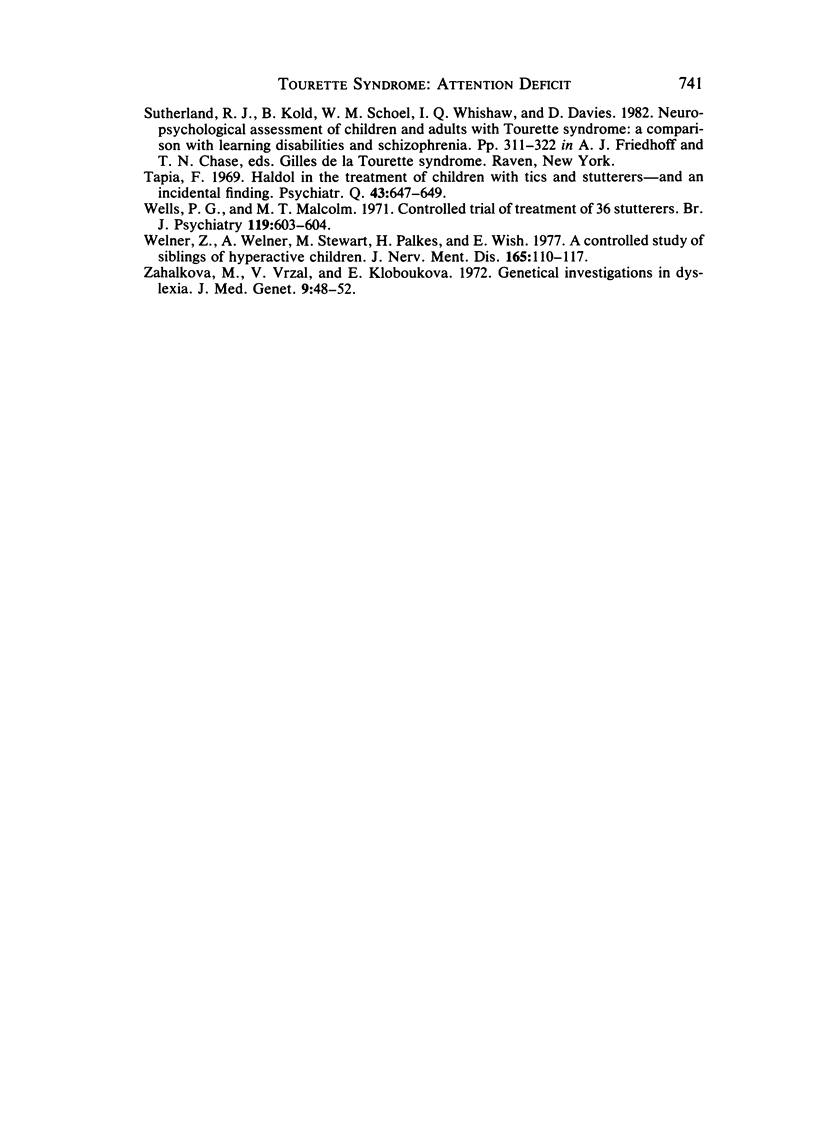
Selected References
These references are in PubMed. This may not be the complete list of references from this article.
- Bachman D. S. Pemoline-induced Tourette's disorder: a case report. Am J Psychiatry. 1981 Aug;138(8):1116–1117. doi: 10.1176/ajp.138.8.1116. [DOI] [PubMed] [Google Scholar]
- Badian N. A. Reading disability in an epidemiological context incidence and environmental correlates. J Learn Disabil. 1984 Mar;17(3):129–136. doi: 10.1177/002221948401700301. [DOI] [PubMed] [Google Scholar]
- Baron M., Shapiro E., Shapiro A., Rainer J. D. Genetic analysis of Tourette syndrome suggesting major gene effect. Am J Hum Genet. 1981 Sep;33(5):767–775. [PMC free article] [PubMed] [Google Scholar]
- Berger M., Yule W., Rutter M. Attainment and adjustment in two geographical areas. II--The prevalence of specific reading retardation. Br J Psychiatry. 1975 Jun;126:510–519. doi: 10.1192/bjp.126.6.510. [DOI] [PubMed] [Google Scholar]
- Bornstein R. A., King G., Carroll A. Neuropsychological abnormalities in Gilles de la Tourette's syndrome. J Nerv Ment Dis. 1983 Aug;171(8):497–502. doi: 10.1097/00005053-198308000-00007. [DOI] [PubMed] [Google Scholar]
- Bremness A. B., Sverd J. Methylphenidate-induced Tourette syndrome: case report. Am J Psychiatry. 1979 Oct;136(10):1334–1335. doi: 10.1176/ajp.136.10.1334. [DOI] [PubMed] [Google Scholar]
- Burns D., Brady J. P., Kuruvilla K. The acute effect of haloperidol and apomorphine on the severity of stuttering. Biol Psychiatry. 1978 Apr;13(2):255–264. [PubMed] [Google Scholar]
- Cadoret R. J., Cunningham L., Loftus R., Edwards J. Studies of adoptees from psychiatrically disturbed biologic parents. II. Temperament, hyperactive, antisocial, and developmental variables. J Pediatr. 1975 Aug;87(2):301–306. doi: 10.1016/s0022-3476(75)80607-x. [DOI] [PMC free article] [PubMed] [Google Scholar]
- Cantwell D. P. Genetic factors in the hyperkinetic syndrome. J Am Acad Child Psychiatry. 1976 Spring;15(2):214–223. doi: 10.1016/s0002-7138(09)61483-7. [DOI] [PubMed] [Google Scholar]
- Cohen D. J., Detlor J., Shaywitz B. A., Leckman J. F. Interaction of biological and psychological factors in the natural history of Tourette syndrome: a paradigm for childhood neuropsychiatric disorders. Adv Neurol. 1982;35:31–40. [PubMed] [Google Scholar]
- Comings D. E. A controlled study of Tourette syndrome. VII. Summary: a common genetic disorder causing disinhibition of the limbic system. Am J Hum Genet. 1987 Nov;41(5):839–866. [PMC free article] [PubMed] [Google Scholar]
- Comings D. E., Comings B. G. A case of familial exhibitionism in Tourette's syndrome successfully treated with haloperidol. Am J Psychiatry. 1982 Jul;139(7):913–915. doi: 10.1176/ajp.139.7.913. [DOI] [PubMed] [Google Scholar]
- Comings D. E., Comings B. G., Devor E. J., Cloninger C. R. Detection of major gene for Gilles de la Tourette syndrome. Am J Hum Genet. 1984 May;36(3):586–600. [PMC free article] [PubMed] [Google Scholar]
- Devor E. J. Complex segregation analysis of Gilles de la Tourette syndrome: further evidence for a major locus mode of transmission. Am J Hum Genet. 1984 May;36(3):704–709. [PMC free article] [PubMed] [Google Scholar]
- Eldridge R., Sweet R., Lake R., Ziegler M., Shapiro A. K. Gilles de la Tourette's syndrome: clinical, genetic, psychologic, and biochemical aspects in 21 selected families. Neurology. 1977 Feb;27(2):115–124. doi: 10.1212/wnl.27.2.115. [DOI] [PubMed] [Google Scholar]
- Finucci J. M., Guthrie J. T., Childs A. L., Abbey H., Childs B. The genetics of specific reading disability. Ann Hum Genet. 1976 Jul;40(1):1–23. doi: 10.1111/j.1469-1809.1976.tb00161.x. [DOI] [PubMed] [Google Scholar]
- Golden G. S. Gilles de la Tourette's syndrome following methylphenidate administration. Dev Med Child Neurol. 1974 Feb;16(1):76–78. doi: 10.1111/j.1469-8749.1974.tb02715.x. [DOI] [PubMed] [Google Scholar]
- HALLGREN B. Specific dyslexia (congenital word-blindness); a clinical and genetic study. Acta Psychiatr Neurol Suppl. 1950;65:1–287. [PubMed] [Google Scholar]
- Hagin R. A., Beecher R., Pagano G., Kreeger H. Effects of Tourette syndrome on learning. Adv Neurol. 1982;35:323–328. [PubMed] [Google Scholar]
- Herschel M. Dyslexia revisited. A review. Hum Genet. 1978 Jan 19;40(2):115–134. doi: 10.1007/BF00272293. [DOI] [PubMed] [Google Scholar]
- Jackson D. M., Andén N. E., Dahlström A. A functional effect of dopamine in the nucleus accumbens and in some other dopamine-rich parts of the rat brain. Psychopharmacologia. 1975 Dec 31;45(2):139–149. doi: 10.1007/BF00429052. [DOI] [PubMed] [Google Scholar]
- Kidd K. K., Prusoff B. A., Cohen D. J. Familial pattern of Gilles de la Tourette syndrome. Arch Gen Psychiatry. 1980 Dec;37(12):1336–1339. doi: 10.1001/archpsyc.1980.01780250022001. [DOI] [PubMed] [Google Scholar]
- Lowe T. L., Cohen D. J., Detlor J., Kremenitzer M. W., Shaywitz B. A. Stimulant medications precipitate Tourette's syndrome. JAMA. 1982 Mar 26;247(12):1729–1731. [PubMed] [Google Scholar]
- Merali Z., Johnston S., Zalcman S. Bombesin-induced behavioural changes: antagonism by neuroleptics. Peptides. 1983 Sep-Oct;4(5):693–697. doi: 10.1016/0196-9781(83)90020-7. [DOI] [PubMed] [Google Scholar]
- Mikkelsen E. J., Detlor J., Cohen D. J. School avoidance and social phobia triggered by haloperidol in patients with Tourette's disorder. Am J Psychiatry. 1981 Dec;138(12):1572–1576. doi: 10.1176/ajp.138.12.1572. [DOI] [PubMed] [Google Scholar]
- Morrison J. R., Stewart M. A. A family study of the hyperactive child syndrome. Biol Psychiatry. 1971;3(3):189–195. [PubMed] [Google Scholar]
- Nee L. E., Caine E. D., Polinsky R. J., Eldridge R., Ebert M. H. Gilles de la Tourette syndrome: clinical and family study of 50 cases. Ann Neurol. 1980 Jan;7(1):41–49. doi: 10.1002/ana.410070109. [DOI] [PubMed] [Google Scholar]
- O'Quinn A. N., Thompson R. J., Jr Tourette's syndrome: an expanded view. Pediatrics. 1980 Sep;66(3):420–424. [PubMed] [Google Scholar]
- Omenn G. S., Weber B. A. Dyslexia: search for phenotypic and genetic heterogeneity. Am J Med Genet. 1978;1(3):333–342. doi: 10.1002/ajmg.1320010310. [DOI] [PubMed] [Google Scholar]
- Parker K. Helping school-age children cope with Tourette syndrome. J Sch Health. 1985 Jan;55(1):30–32. doi: 10.1111/j.1746-1561.1985.tb04071.x. [DOI] [PubMed] [Google Scholar]
- Pauls D. L., Cohen D. J., Heimbuch R., Detlor J., Kidd K. K. Familial pattern and transmission of Gilles de la Tourette syndrome and multiple tics. Arch Gen Psychiatry. 1981 Oct;38(10):1091–1093. doi: 10.1001/archpsyc.1981.01780350025002. [DOI] [PubMed] [Google Scholar]
- Pauls D. L., Hurst C. R., Kruger S. D., Leckman J. F., Kidd K. K., Cohen D. J. Gilles de la Tourette's syndrome and attention deficit disorder with hyperactivity. Evidence against a genetic relationship. Arch Gen Psychiatry. 1986 Dec;43(12):1177–1179. doi: 10.1001/archpsyc.1986.01800120063012. [DOI] [PubMed] [Google Scholar]
- Pauls D. L., Leckman J. F. The inheritance of Gilles de la Tourette's syndrome and associated behaviors. Evidence for autosomal dominant transmission. N Engl J Med. 1986 Oct 16;315(16):993–997. doi: 10.1056/NEJM198610163151604. [DOI] [PubMed] [Google Scholar]
- Pert A., Moody T. W., Pert C. B., Dewald L. A., Rivier J. Bombesin: receptor distribution in brain and effects on nociception and locomotor activity. Brain Res. 1980 Jul 7;193(1):209–220. doi: 10.1016/0006-8993(80)90958-0. [DOI] [PubMed] [Google Scholar]
- Pollack M. A., Cohen N. L., Friedhoff A. J. Gilles de la Tourette's syndrome. Familial occurrence and precipitation by methylphenidate therapy. Arch Neurol. 1977 Oct;34(10):630–632. doi: 10.1001/archneur.1977.00500220064011. [DOI] [PubMed] [Google Scholar]
- Price R. A., Leckman J. F., Pauls D. L., Cohen D. J., Kidd K. K. Gilles de la Tourette's syndrome: tics and central nervous system stimulants in twins and nontwins. Neurology. 1986 Feb;36(2):232–237. doi: 10.1212/wnl.36.2.232. [DOI] [PubMed] [Google Scholar]
- Quinn P. T., Peachey E. C. Haloperidol in the treatment of stutterers. Br J Psychiatry. 1973 Aug;123(573):247–248. doi: 10.1192/bjp.123.2.247. [DOI] [PubMed] [Google Scholar]
- Robins L. N., Helzer J. E., Croughan J., Ratcliff K. S. National Institute of Mental Health Diagnostic Interview Schedule. Its history, characteristics, and validity. Arch Gen Psychiatry. 1981 Apr;38(4):381–389. doi: 10.1001/archpsyc.1981.01780290015001. [DOI] [PubMed] [Google Scholar]
- Safer D. J. "A familial factor in minimal brain dysfunction. Behav Genet. 1973 Jun;3(2):175–186. doi: 10.1007/BF01067657. [DOI] [PubMed] [Google Scholar]
- Schulz D. W., Kalivas P. W., Nemeroff C. B., Prange A. J., Jr Bombesin-induced locomotor hyperactivity: evaluation of the involvement of the mesolimbic dopamine system. Brain Res. 1984 Jun 25;304(2):377–382. doi: 10.1016/0006-8993(84)90343-3. [DOI] [PubMed] [Google Scholar]
- Shapiro A. K., Shapiro E. Do stimulants provoke, cause, or exacerbate tics and Tourette syndrome? Compr Psychiatry. 1981 May-Jun;22(3):265–273. doi: 10.1016/0010-440x(81)90084-5. [DOI] [PubMed] [Google Scholar]
- Shapiro A. K., Shapiro E., Wayne H., Clarkin J. Organic factors in Gilles de la Tourette's syndrome. Br J Psychiatry. 1973 Jun;122(571):659–664. doi: 10.1192/bjp.122.6.659. [DOI] [PubMed] [Google Scholar]
- Sleator E. K. Deleterious effects of drugs used for hyperactivity on patients with Gilles de la Tourette syndrome. Clin Pediatr (Phila) 1980 Jul;19(7):453–454. doi: 10.1177/000992288001900704. [DOI] [PubMed] [Google Scholar]
- Stefl M. E., Rubin M. Tourette syndrome in the classroom: special problems, special needs. J Sch Health. 1985 Feb;55(2):72–75. doi: 10.1111/j.1746-1561.1985.tb04083.x. [DOI] [PubMed] [Google Scholar]
- Sutherland R. J., Kolb B., Schoel W. M., Whishaw I. Q., Davies D. Neuropsychological assessment of children and adults with Tourette syndrome: a comparison with learning disabilities and schizophrenia. Adv Neurol. 1982;35:311–322. [PubMed] [Google Scholar]
- Tapia F. Haldol in the treatment of children with tics and stutterers--and an incidental finding. Psychiatr Q. 1969;43(4):647–649. doi: 10.1007/BF01564276. [DOI] [PubMed] [Google Scholar]
- Wells P. G., Malcolm M. T. Controlled trial of the treatment of 36 stutterers. Br J Psychiatry. 1971 Dec;119(553):603–604. doi: 10.1192/bjp.119.553.603. [DOI] [PubMed] [Google Scholar]
- Welner Z., Welner A., Stewart M., Palkes H., Wish E. A controlled study of siblings of hyperactive children. J Nerv Ment Dis. 1977 Aug;165(2):110–117. doi: 10.1097/00005053-197708000-00004. [DOI] [PubMed] [Google Scholar]
- Zahálková M., Vrzal V., Klobouková E. Genetical investigations in dyslexia. J Med Genet. 1972 Mar;9(1):48–52. doi: 10.1136/jmg.9.1.48. [DOI] [PMC free article] [PubMed] [Google Scholar]


